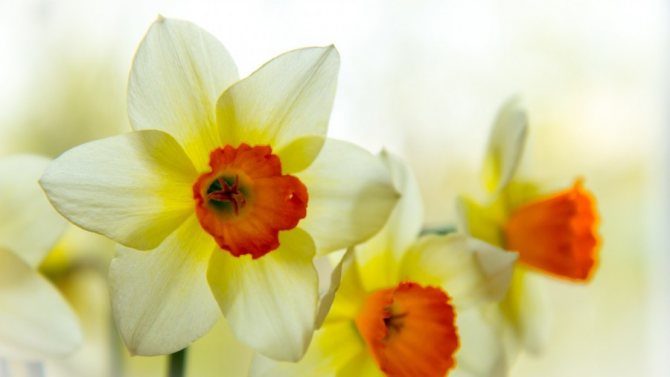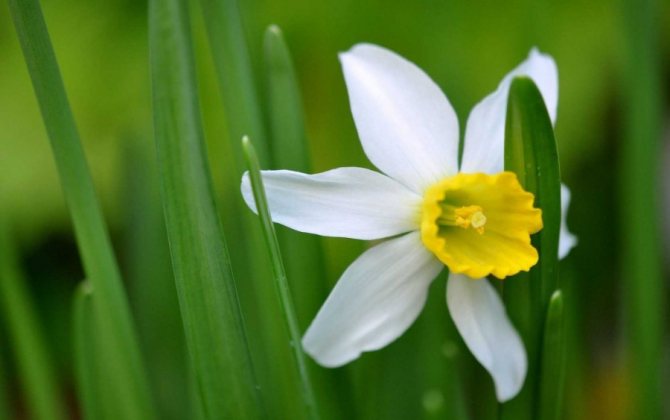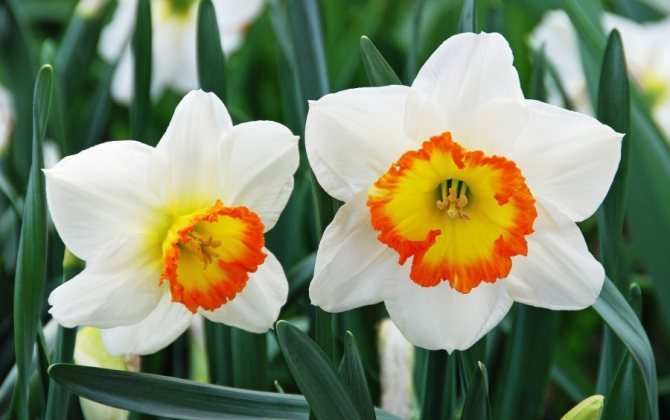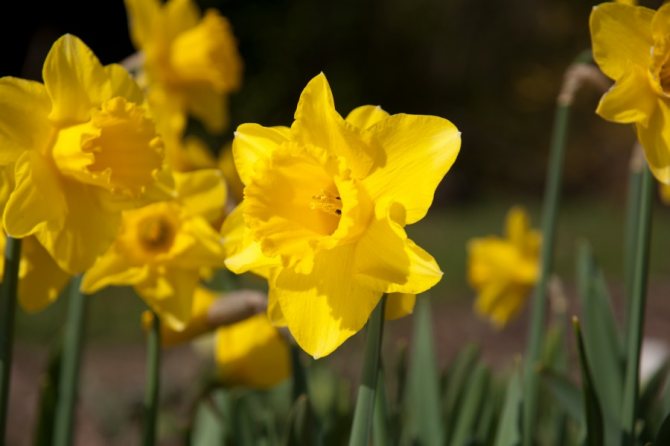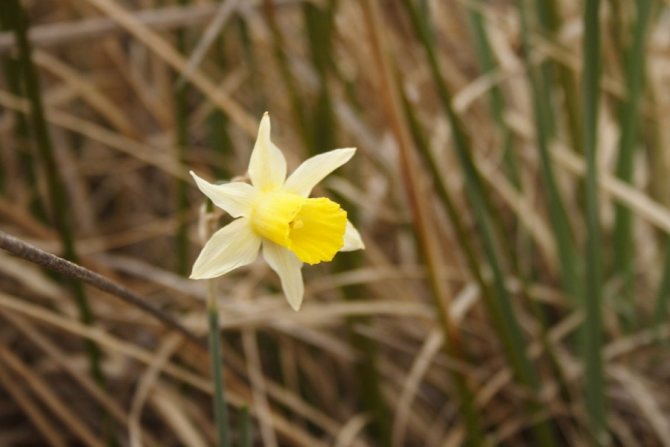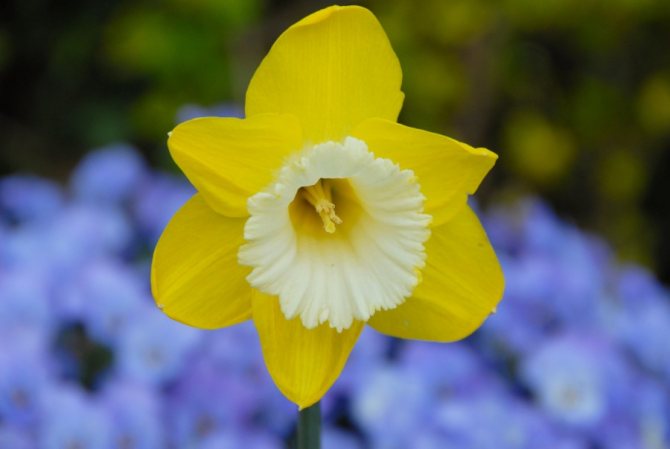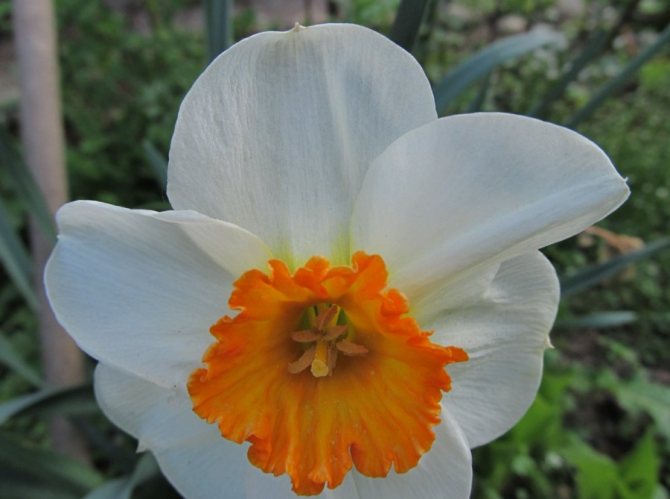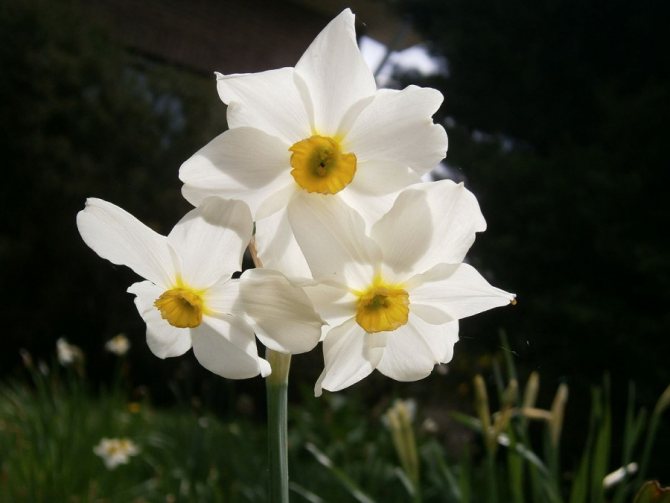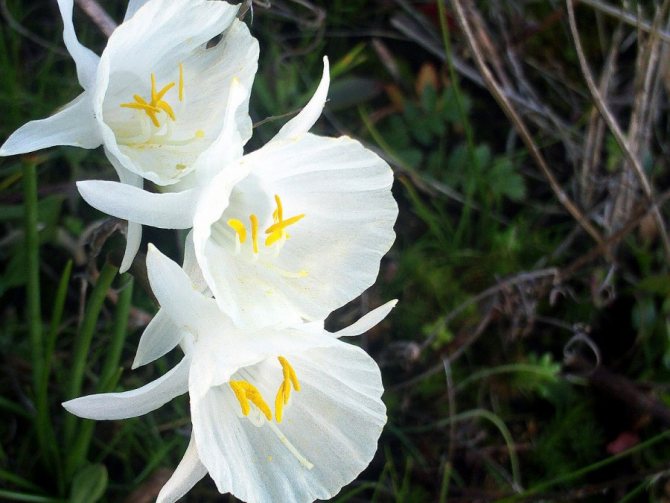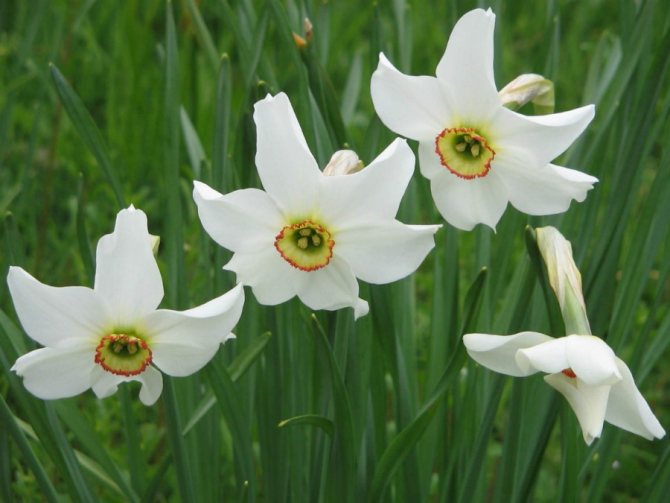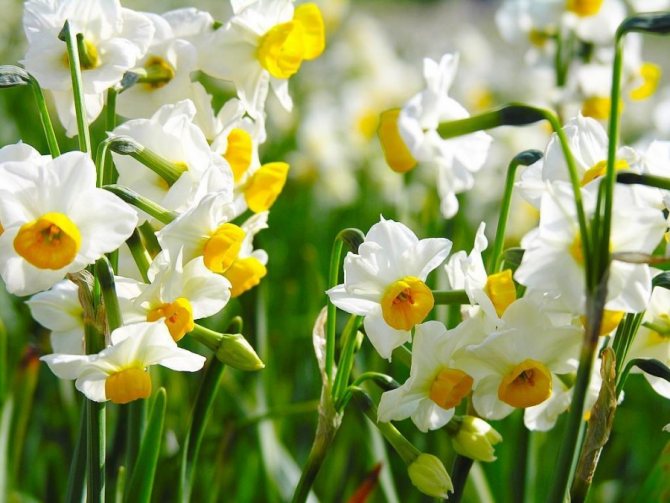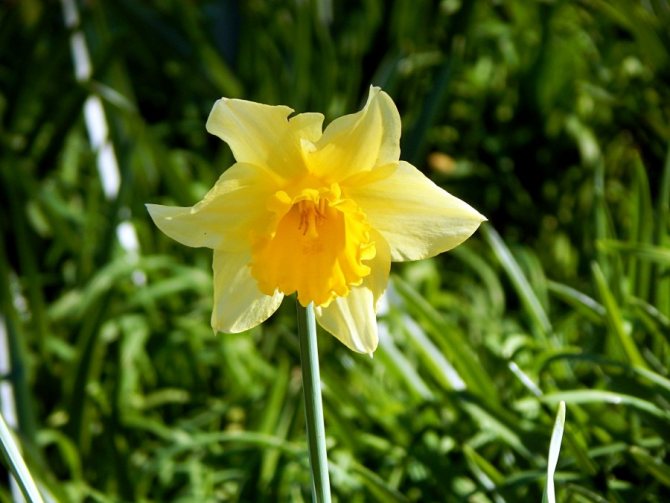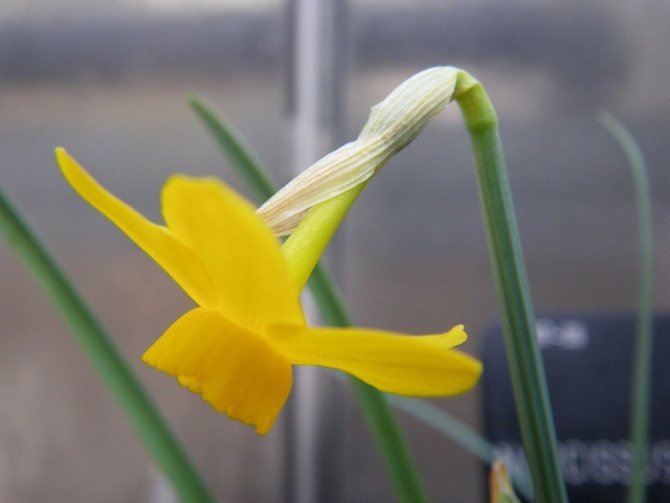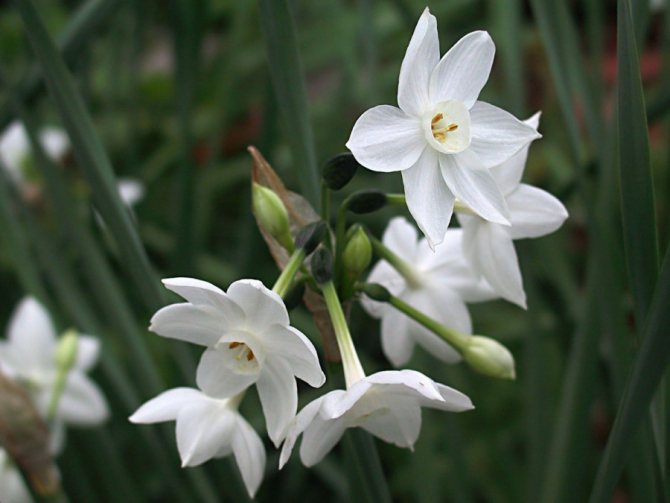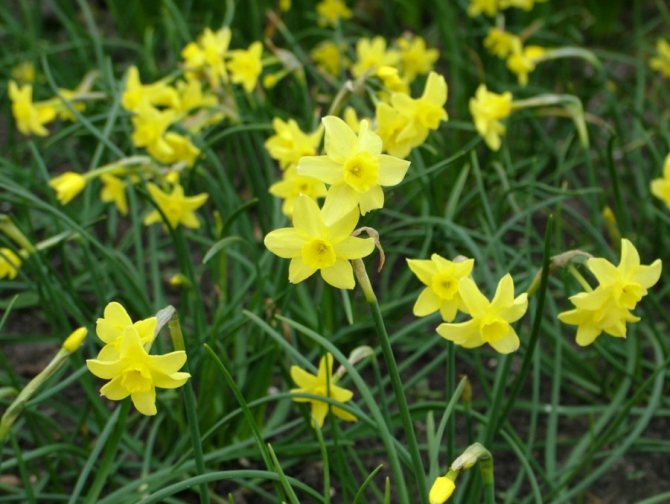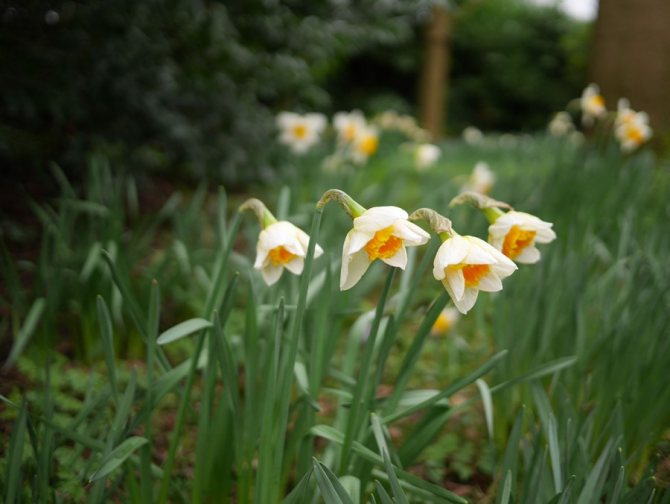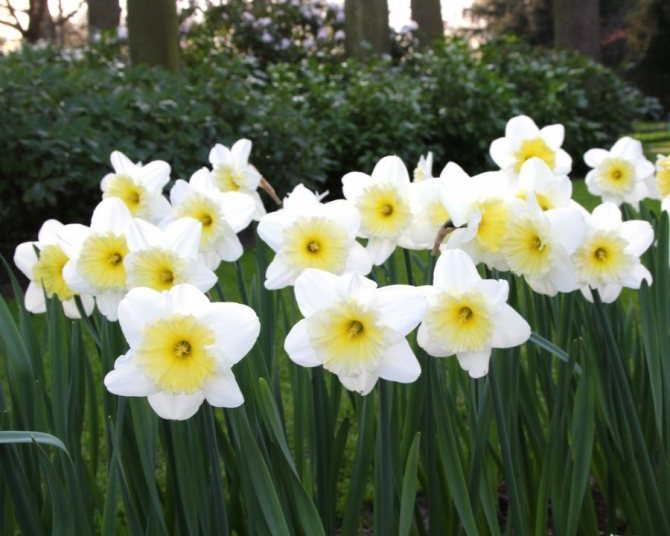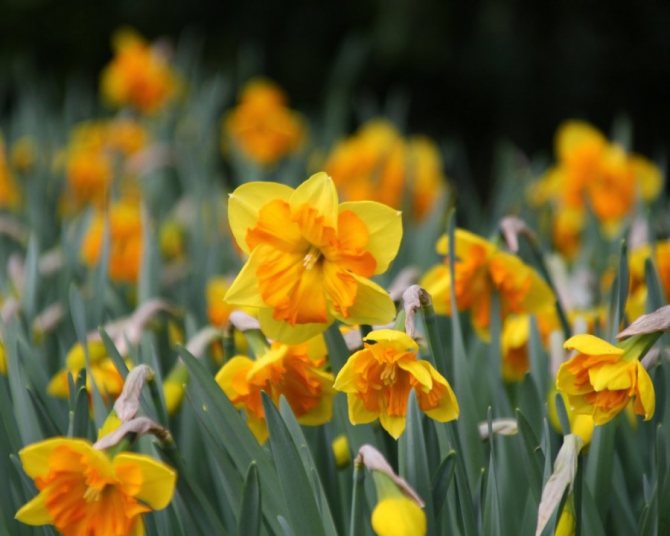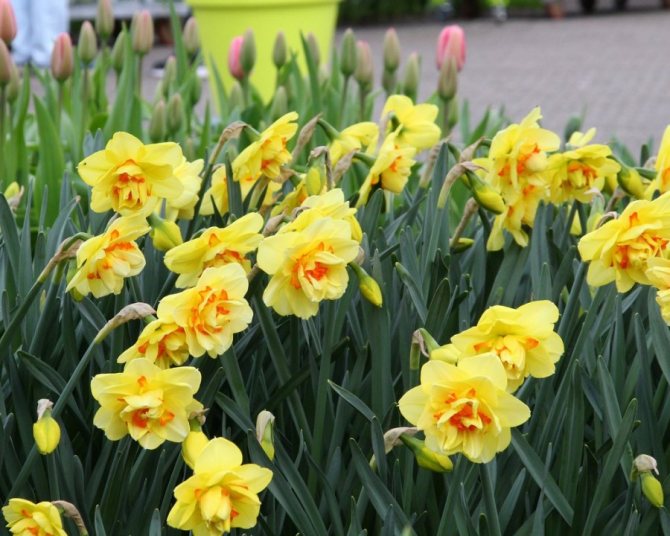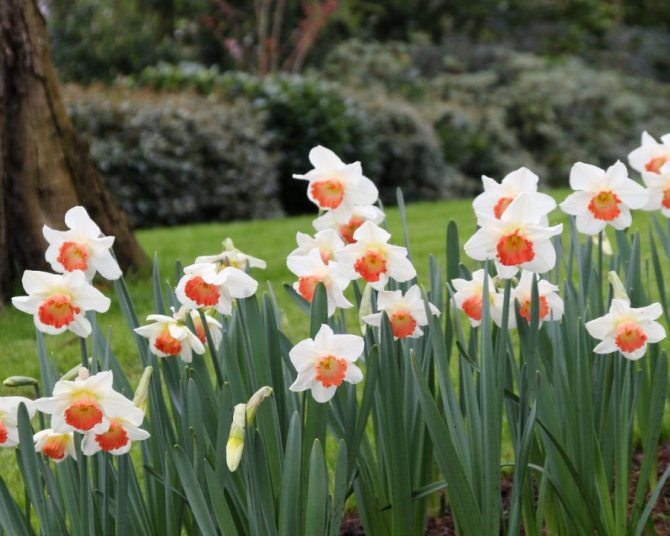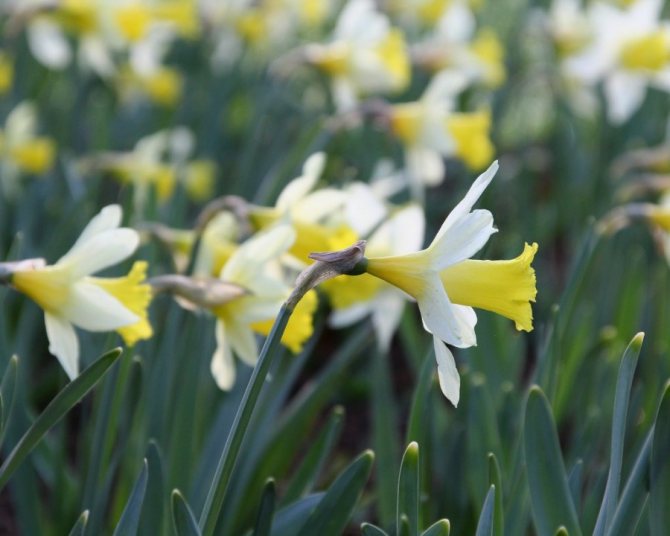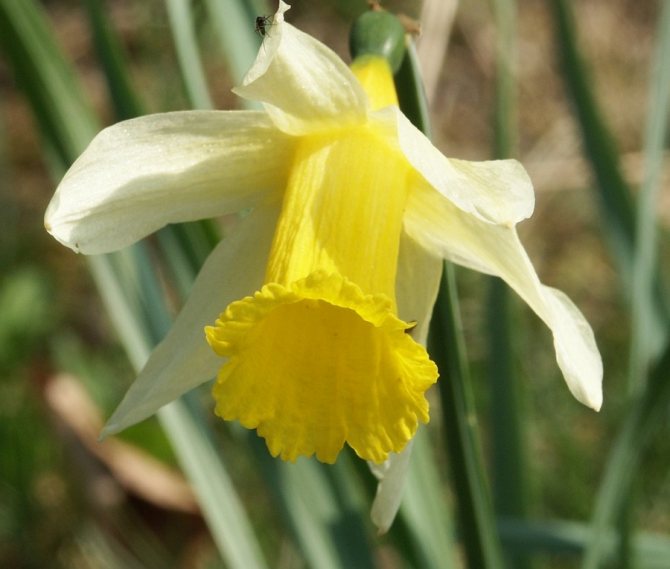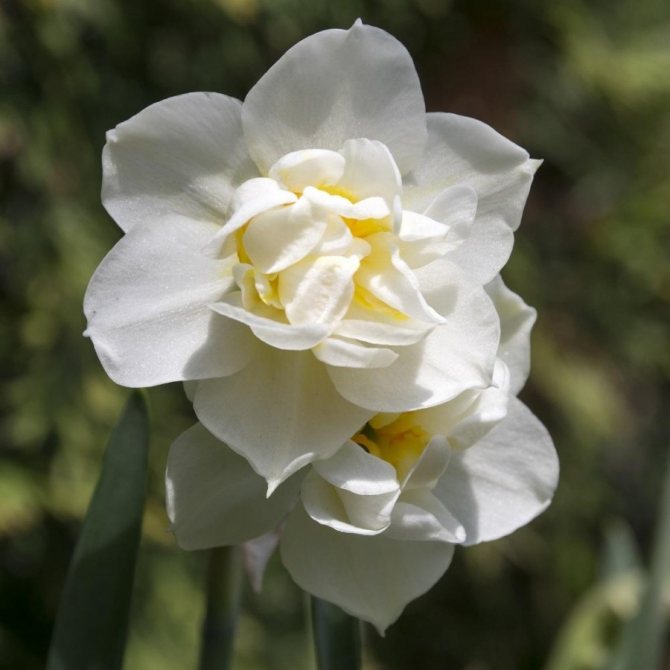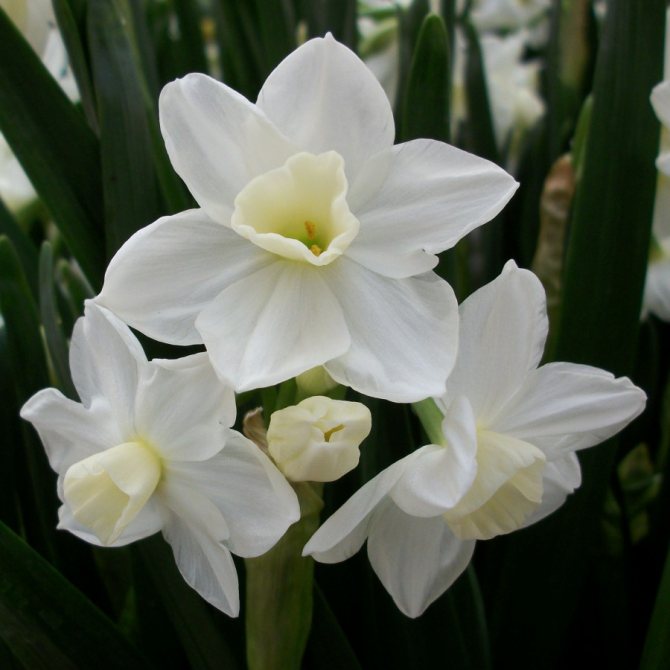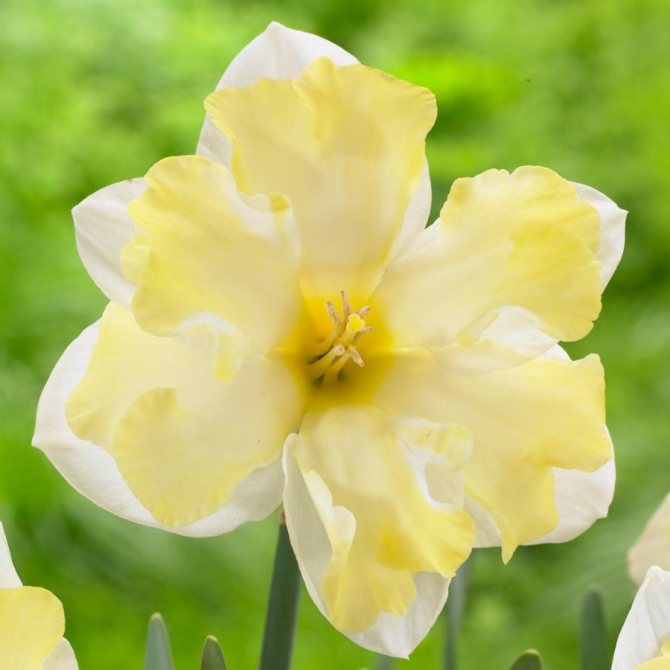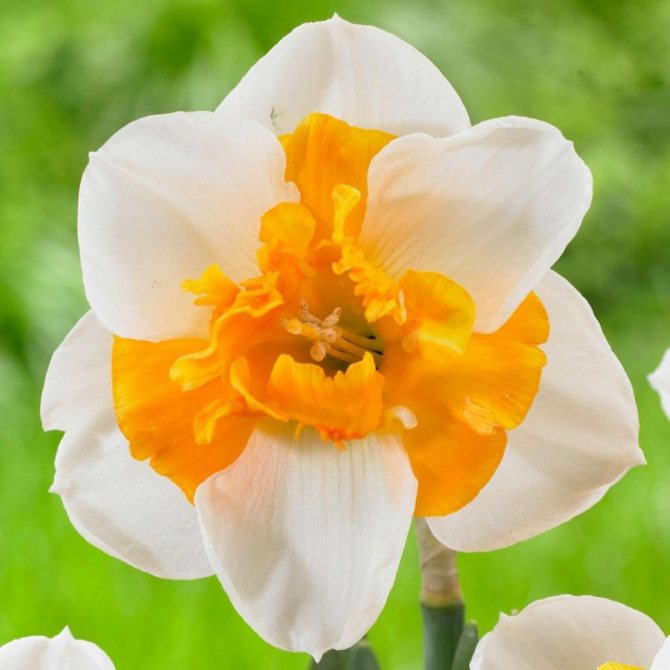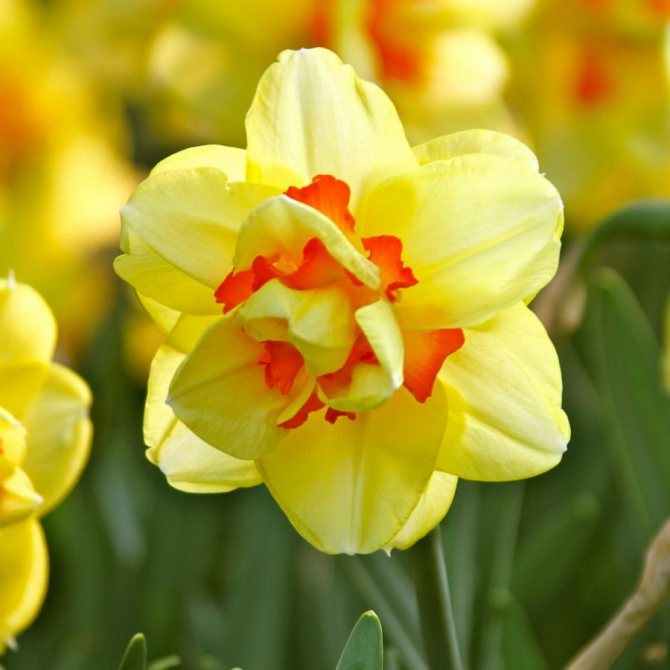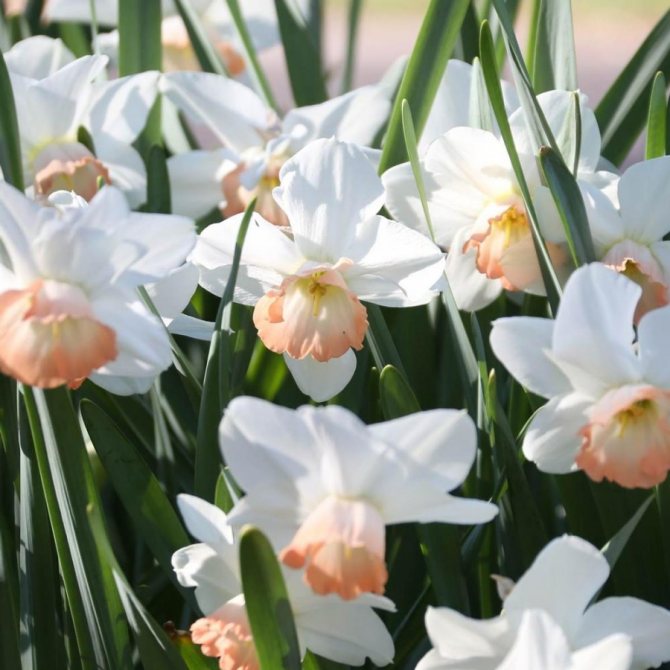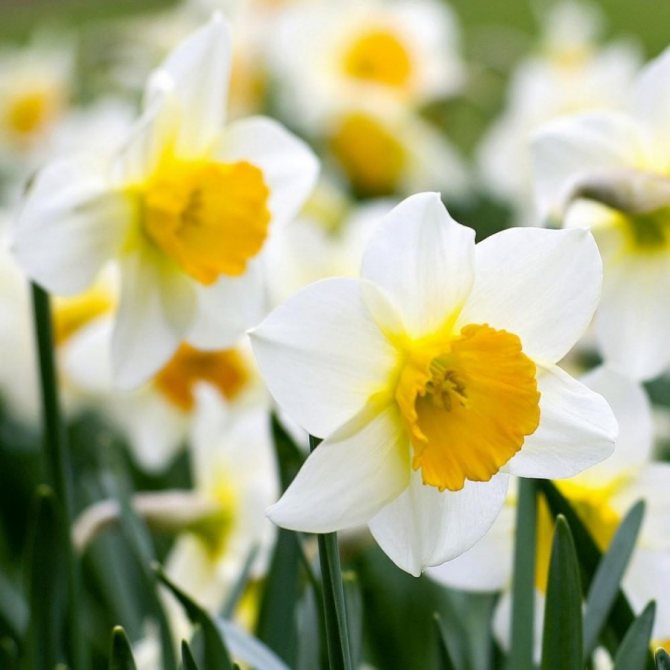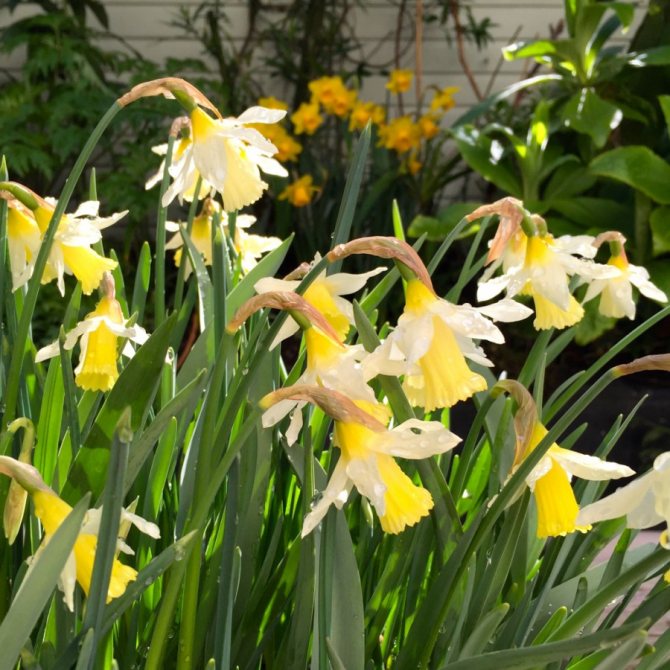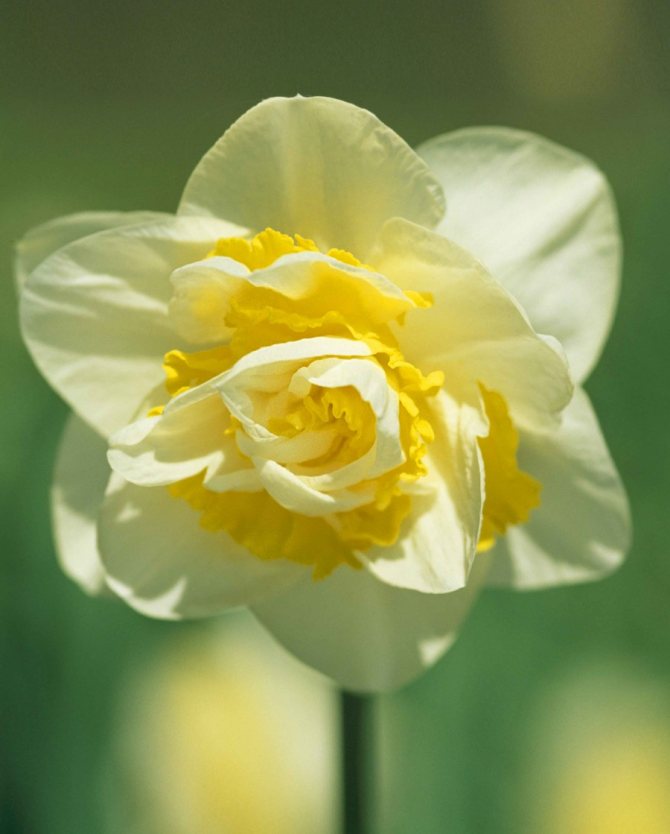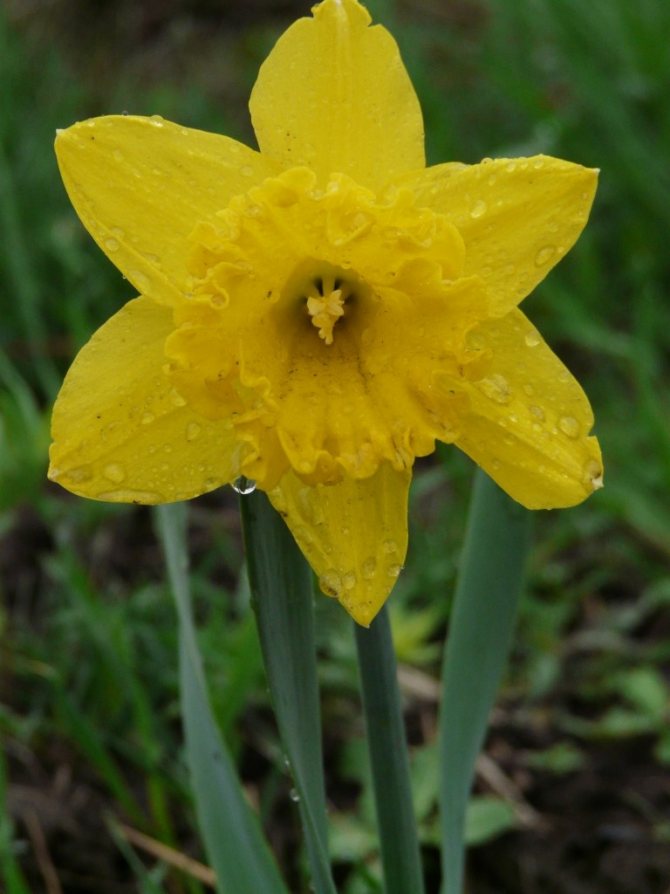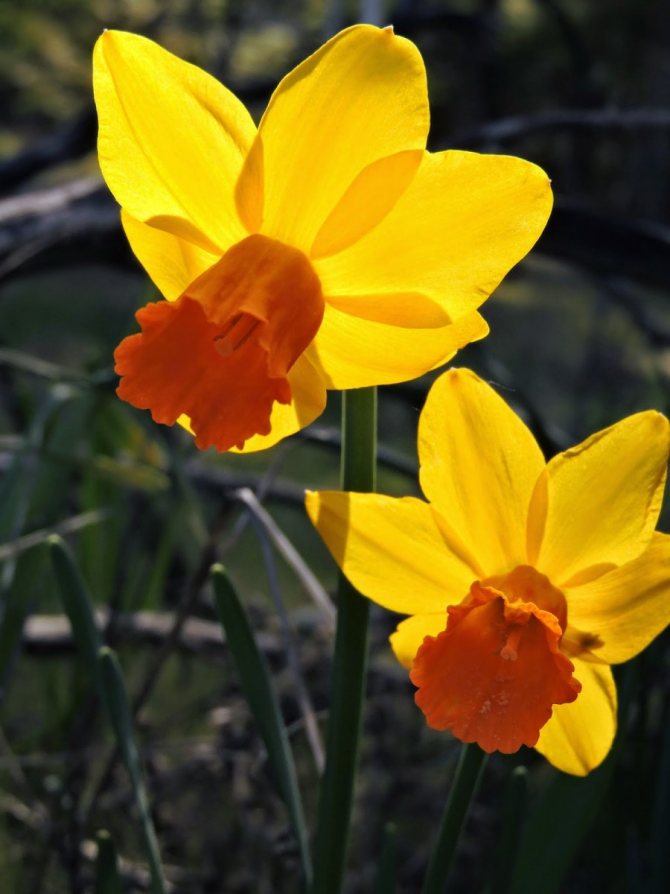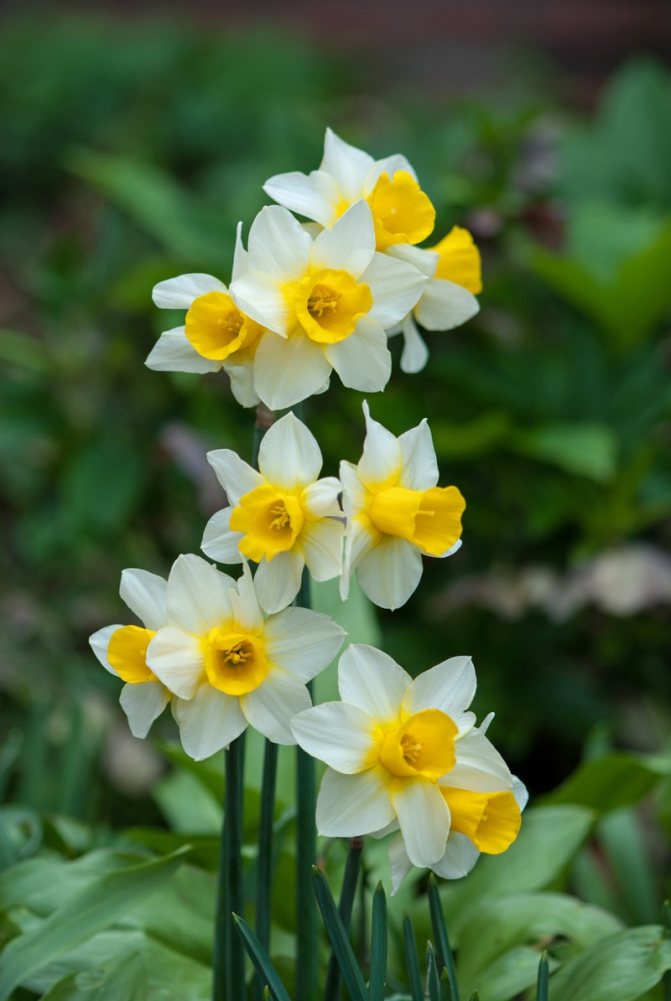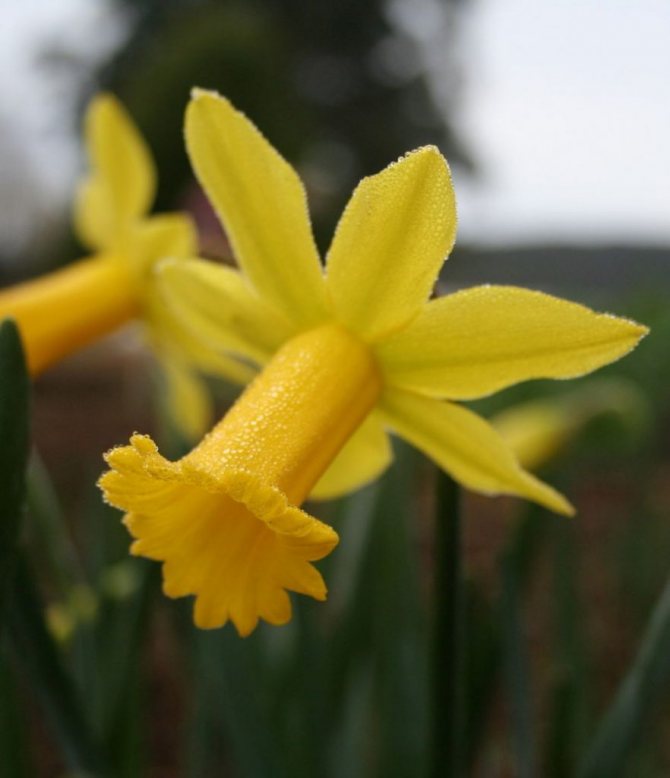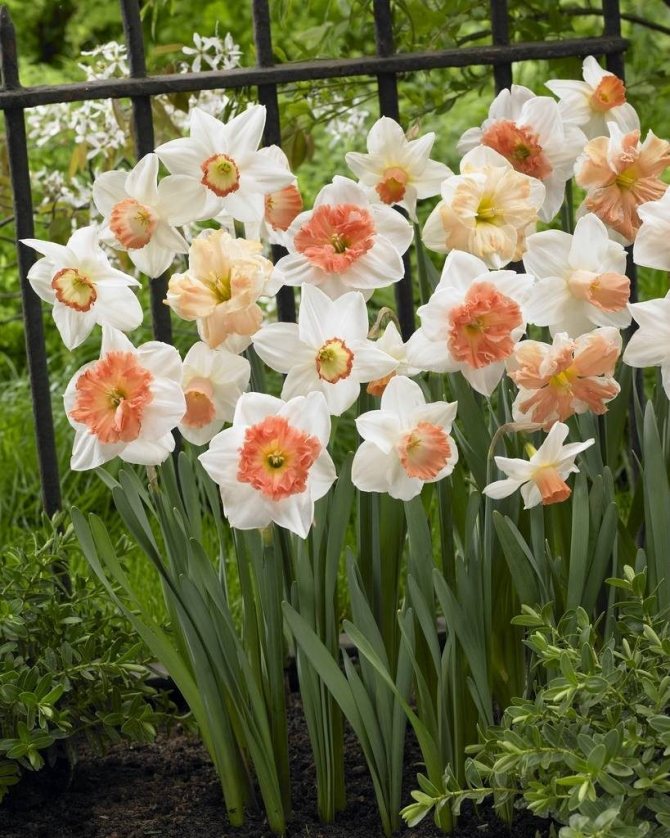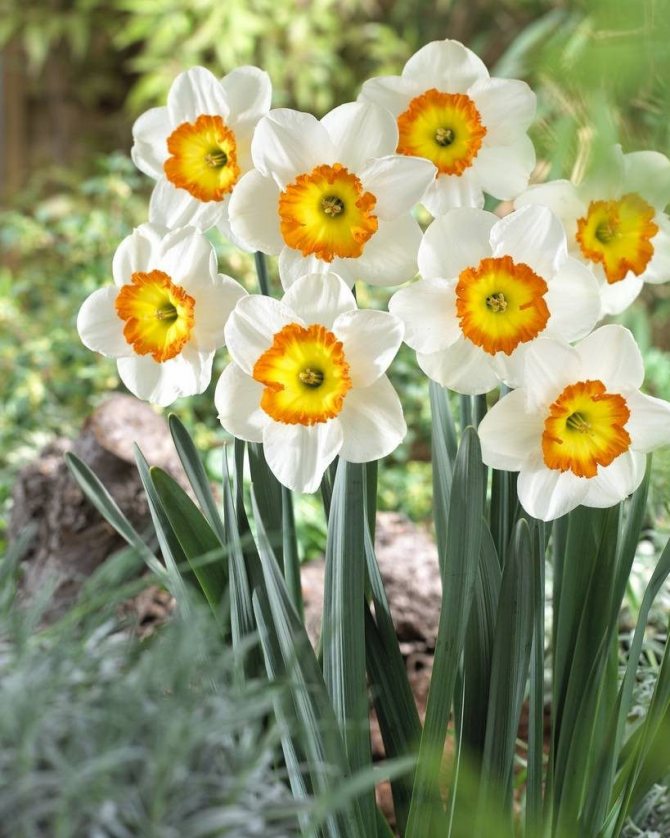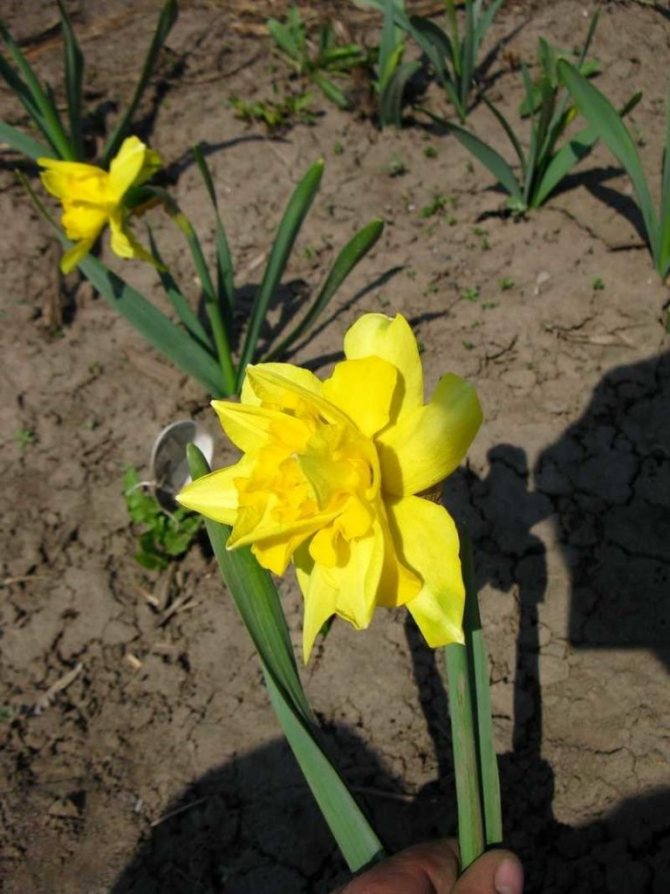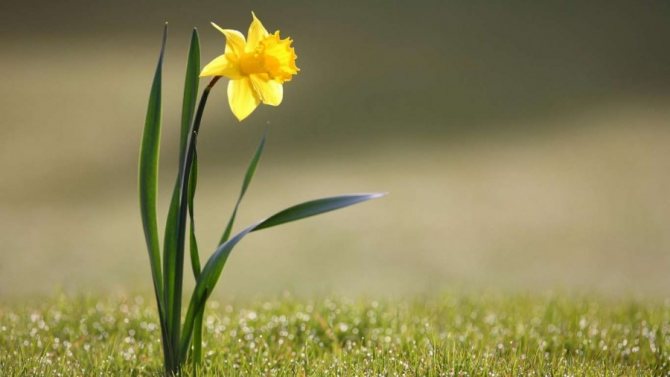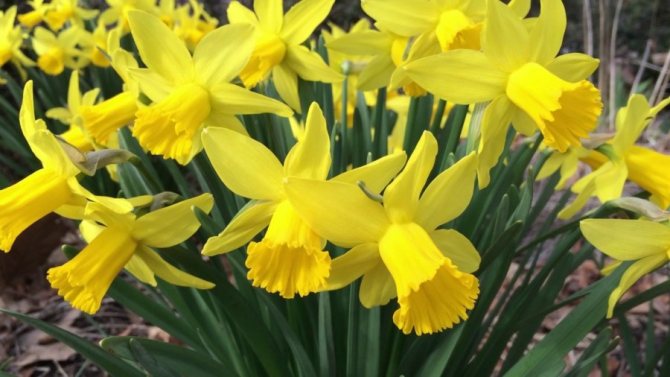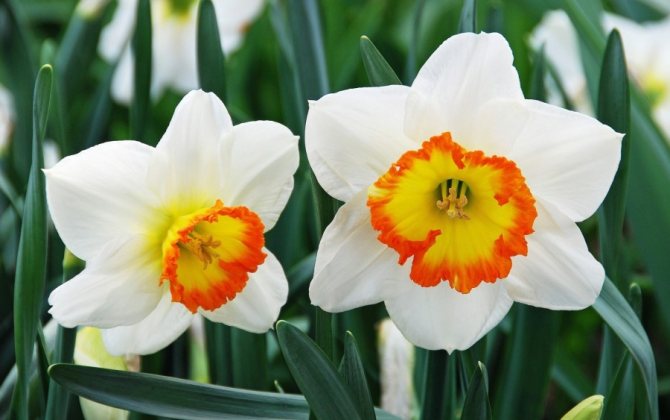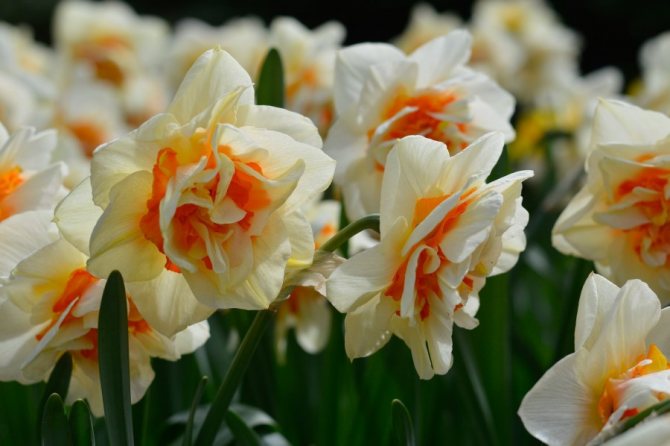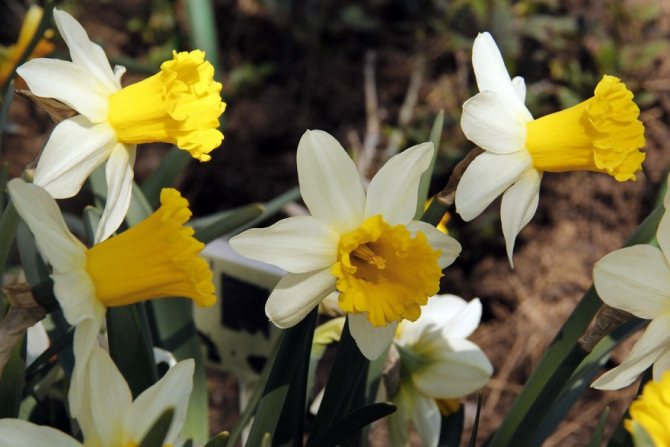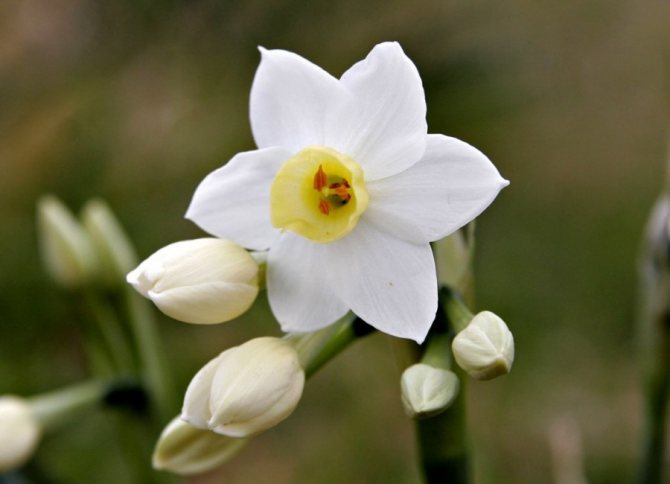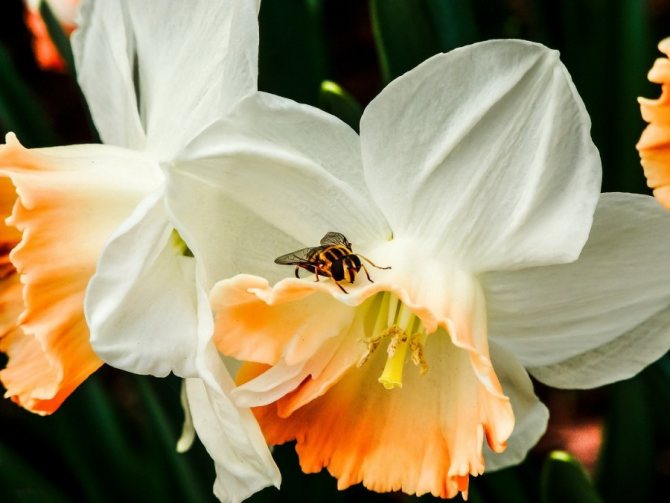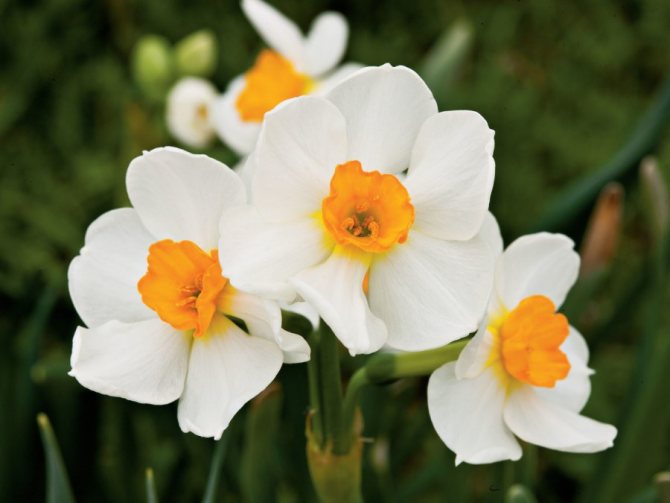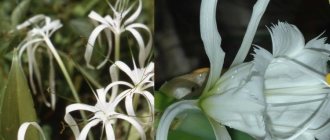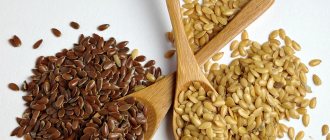Category: Garden plants.
Narcissus (lat.Narcissus) - a genus of plants of the Amaryllis family, growing in Asia, Southern Europe and the Mediterranean, which includes 54 primary and 59 hybridogenic species. The scientific name Narcissus comes from the Greek word meaning "intoxicate." Perhaps the name of the plant contains a hint of the intoxicating scent of its flowers, but perhaps the daffodil was so named because of the poisonous properties of its bulbs.
In ancient Persia, the plant was called "nargis", and in modern Iran - "narges", which means "beautiful eye": poets often compare the beauty of a daffodil with the beautiful eyes of lovers. Mohammed said about a flower: "Whoever has two loaves, let him sell one to buy a daffodil flower, for bread is food for the body, and a daffodil is food for the soul." And the ancient Greeks have such a legend about the daffodil: a narcissistic young man named Narcissus, who rejected the love of a mountain nymph, was severely punished for his callousness by Aphrodite, who made him fall in love with his own reflection in the stream so much that the young man could not leave the wilderness, without tired of admiring themselves. There he died of self-love, and his body turned into a beautiful fragrant flower, which was named daffodil. Since then, narcissists have been called people who are distinguished by exceptional narcissism.
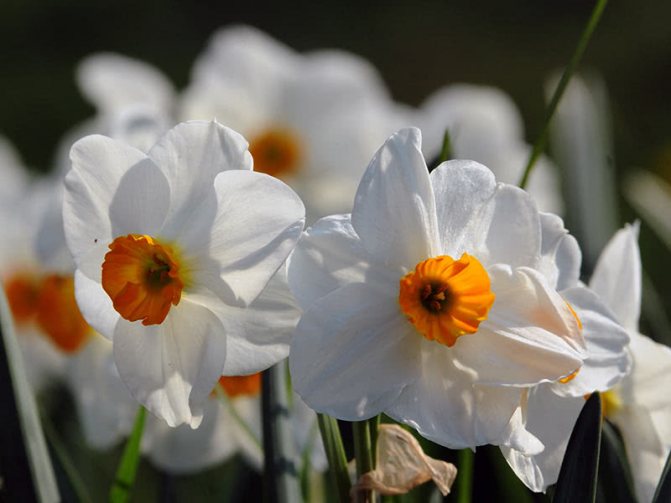
Choosing a landing site
Plants are warm and light-requiring. But for them, the location in sunny areas is not fundamental. Daffodils feel quite comfortable in the shade. But the following features must be taken into account:
- In the sun, the bush forms more peduncles, while their height is lower than the declared varietal qualities.
- In the shade, the daffodil stretches out, but there may be few flowers.
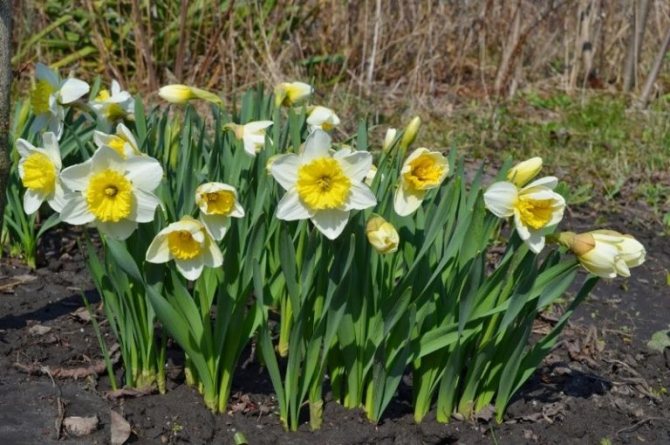

The best solution for a plant is an openwork partial shade. In the southern regions, you can fearlessly place flowers in the shade of trees and bushes. But in the north, it is advisable to choose open sunny territories for them.
Photo of a daffodil
Boarding time
When to plant bulbous plants largely depends on the state of the planting material, the desired flowering time. It is advisable to plant daffodils in the fall. With this approach, they will bloom next spring. Bulbs must be examined, dry and diseased are discarded. The planting material must be dry, covered with dense scales.
Industrial daffodils do not need additional processing. They can be planted immediately after purchase. The optimal time for the middle lane is the end of August and the beginning of September. For the southern regions - September and October. It is advisable to disinfect your own material or material purchased from private sellers by treating it in a 1% solution of potassium permanganate.
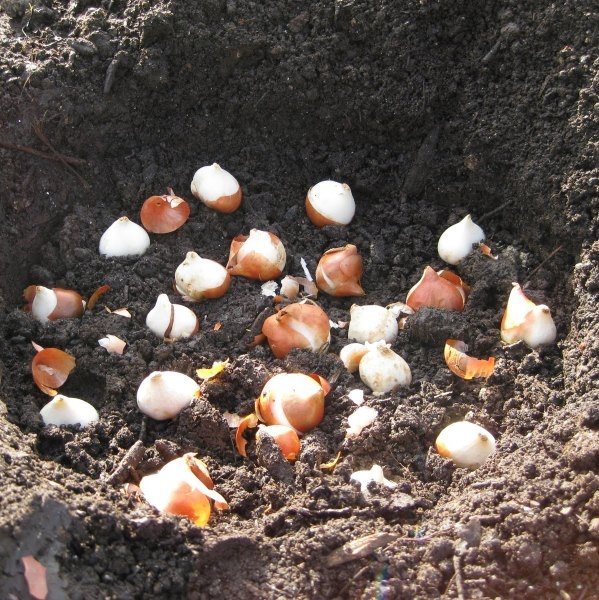

Planting bulbs in spring is also possible. But they will bloom late and only if done early. This is usually done with planting material that was used for forcing in winter. The task of such daffodils is to strengthen the depleted onion.
Plants purchased in spring in flower shops may well bloom. They are usually stored in cold storage rooms, which encourages their rapid growth outdoors. It is advisable to store your own planting material in a cool, dark room. Put in the refrigerator 2 months before planting.
Reproduction of daffodils
Daffodils also reproduce by seed, although it is not as popular as dividing the bulbs. Seeds are sown in boxes or in open ground immediately after harvest, while still wet: the seeding depth of the seed is three diameters of the seed. Seedling care does not contain any peculiarities, however, it is advisable not to disturb the seedlings for the first two years so that they can grow a strong bulb, and only after that they are planted in open ground. Daffodils from seeds bloom in the sixth or seventh year, and small-flowered varieties can produce flowers even in the third or fourth year. Recall that only species plants are propagated by seeds, since varietal traits are not preserved during generative reproduction, and hybrid forms and varieties of daffodils are propagated vegetatively.
Soil preparation
Plants are not picky about the composition of the soil. But they still feel better on neutral loams. As a supplement, it will not be superfluous to introduce nitroammophoska at the rate of 60 g per 1 m2. You can also add humus or compost.
Acidic and alkaline soils require correction. Sour soil is neutralized by introducing 250 g of wood ash per 1 m2. Alkaline soils require the addition of dolomite flour at the rate of 200 g per 1 m2. Daffodils love loose, fertile, well-drained areas. It is advisable to dilute heavy soil with sand. Add humus to the sandy soil.
Planting
Depending on the density of the soil, the bulbs are placed at different depths: heavy soil - 5-7 centimeters, light - 15 centimeters. This rule is important for flowering buds.
The distance between the rows when planting should be about 30 centimeters, and between flowers no more than 25 centimeters. Bulbs should not be less than one centimeter. It is noteworthy that when close to each other, the buds grow larger.
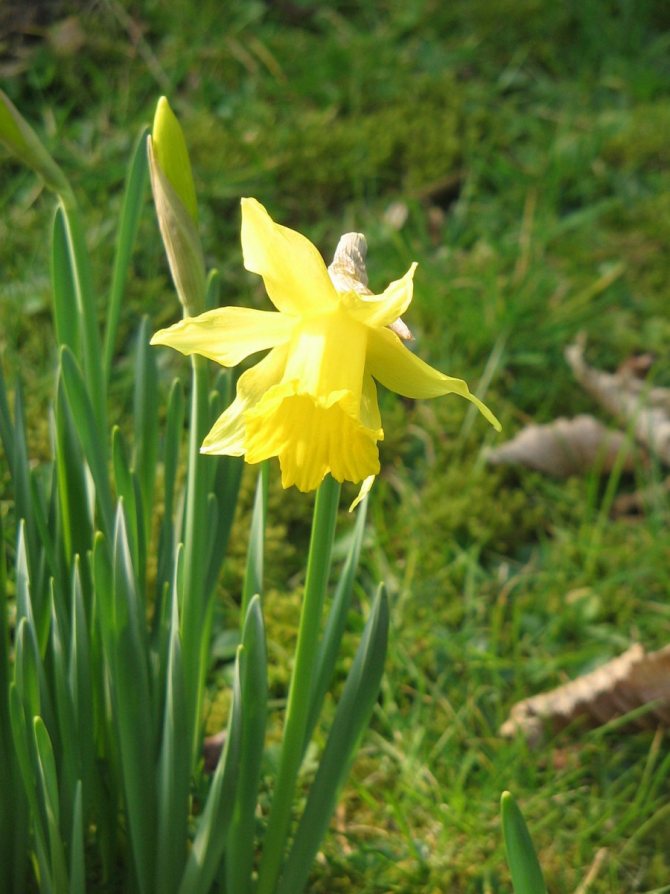

Two weeks after planting, it is necessary to level the topsoil and sprinkle it with humus or peat in a thin layer.
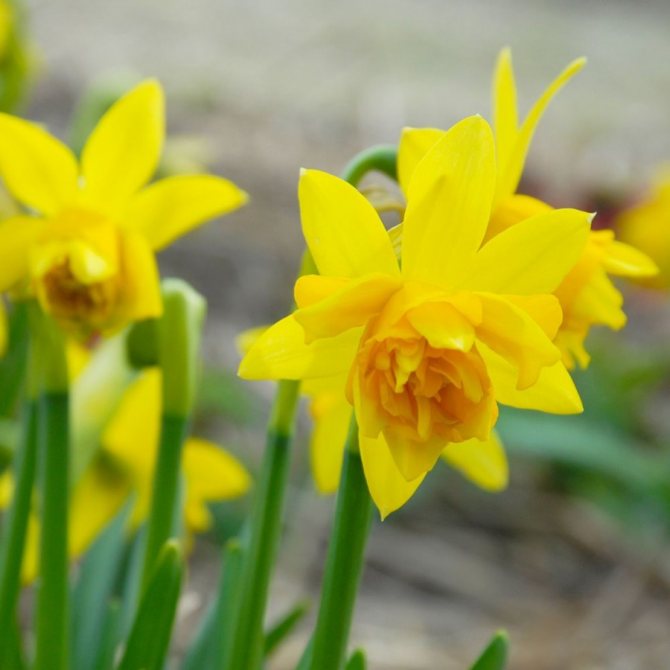

Landing rules
Planting of bulbs is carried out in the same way in both spring and autumn. The only difference is that in the fall, the area with flowers must be additionally covered with leaves of fruit trees or walnuts to protect it from frost.
For the correct planting of daffodils, you must:
- Dig holes. The depth is calculated by multiplying the diameter of the bulb by 3. For example, the size of the planting material is 5 cm. In this case, the depth of the hole will be about 15 cm. But even for small bulbs, you should not make the hole shallower than 10 cm.
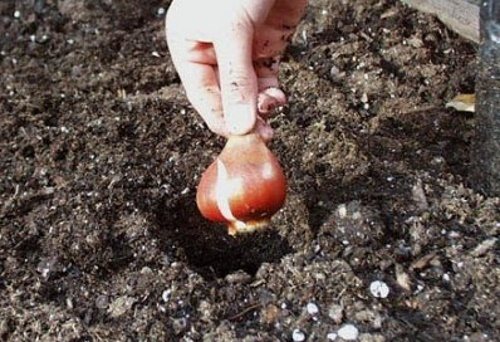

- For large daffodils, it is necessary to maintain a distance between the holes of 20-25 cm. Small bulbs, which are to be grown and then transplanted to a permanent place, can be planted at a distance of 10 cm from each other.
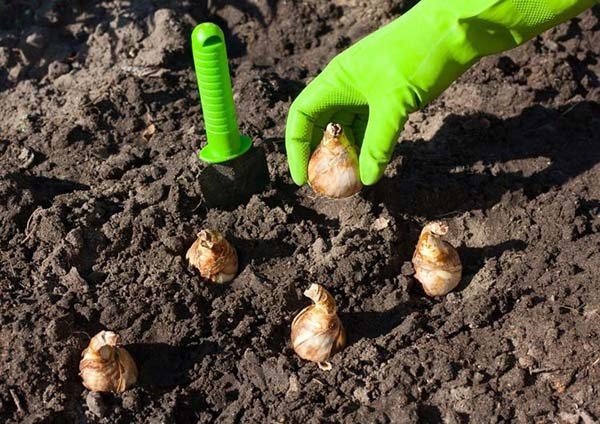

- Add prepared substrate of sand, humus or compost to each hole. Additionally, you can add wood ash, it will have a positive effect on the growth of the flower.
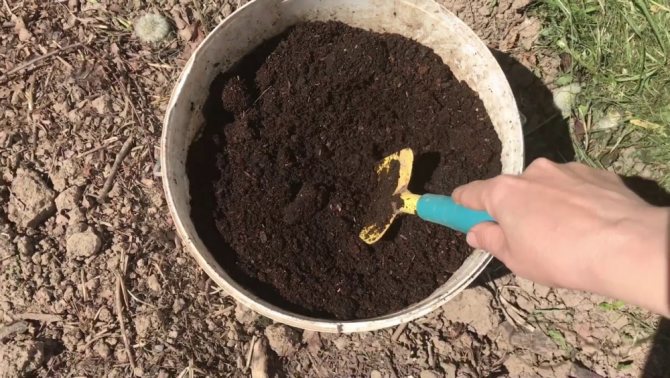

- Place one onion in each hole and pour a little.
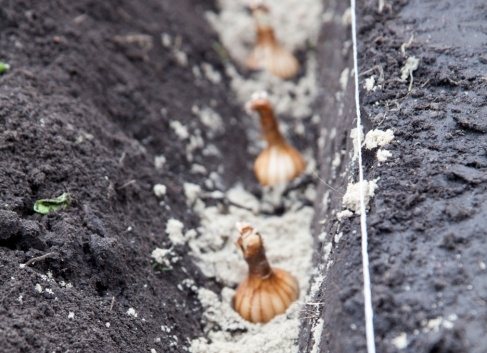

- Cover the landing holes with earth. Loosen the landing site. It is allowed to mulch the site with sawdust, mowed grass or straw about 4 cm thick.


Daffodils and tulips are traditional spring flowers. But it is undesirable to plant them nearby. Daffodils generally dislike the company of bulbous plants. They feel much more comfortable with legumes, nightshades, cereals.
Planting a daffodil outdoors
Daffodil soil
The main requirement for the soil in which daffodils will be grown is fertility and good moisture capacity. As for the pH of the soil, the range from slightly alkaline to slightly acidic is acceptable for daffodils - 6.5-4.9 pH. Most of all, the tastes of daffodils correspond to loam of a neutral reaction, fertilized with compost or humus, but not manure: this organic fertilizer can only be applied under the culture preceding the daffodils. Swampy and calcareous soils are considered unsuitable for growing daffodils. You can not plant daffodils where they grew before tulips, lilies and other bulbous perennials, as well asters, phloxes and chrysanthemums... And here peonies, cucumbers, legumes, grains and nightshades are the best precursors for daffodils.Daffodils are photophilous, so the site should be well lit by the sun. In one place, flowers can grow from three to five years.
About six months before planting, the site is dug to the depth of a shovel bayonet with humus or compost (5-8 kg / m²). If necessary, sand is also added to the soil. As for mineral fertilizers, they are applied two weeks before planting, spending 60 g of Nitrofoski for each m² of the plot.
When to plant daffodils
Traditionally, bulbous crops are planted in the garden in autumn: in the middle lane - in August-September, in the southern regions - in September-October, and sometimes even in November. The term is set based on the fact that the bulb needs 3-4 weeks for rooting. If you decide to plant daffodils in the spring, you will have to stratify the planting material for two months in the vegetable box of the refrigerator, otherwise rooting can be complicated, and problems may arise with flowering in the future. Stratified daffodil bulbs are planted in the flower bed from mid to late April, when the soil temperature rises to 5-7 ºC.
Planting daffodils in the ground
Before planting, the bulbs are examined and those that show damage or signs of disease are discarded. Soft bulbs are also not suitable for planting. Healthy material is disinfected for half an hour in a 1% potassium permanganate solution or in a 3% Fundazole solution.
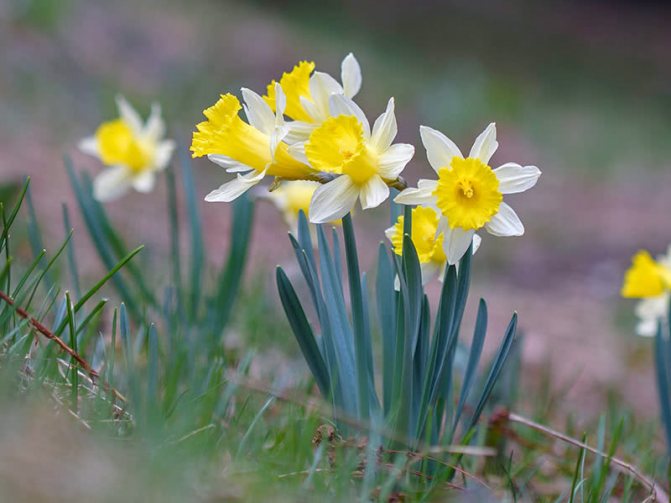

You need to plant daffodils in holes with a depth equal to three diameters of the bulb: pour a handful of sand and a couple of tablespoons of wood ash into the planting hole, lay the onion on the sand, fill the hole with soil halfway, water and complete the planting, filling the remaining space with soil. The distance between the holes depends on whether you are going to grow daffodils in this place for a long time or plant them after a year. In the first case, the distance should be at least 15 cm, and in the second, an interval of 7-10 cm will be sufficient.
Flower feeding
In order to grow luxurious bouquets at home as on the shelves of flower shops, it is necessary to apply fertilizer in a timely manner. Most flower growers agree that two-time feeding is enough for early-flowering spring plants.
- During the budding period. Narcissus needs a complex mineral fertilizer. You can buy a ready-made product, or you can make the mixture yourself. In 10 liters of water, dissolve 1 teaspoon of potassium sulfate, superphosphate, urea. The solution is applied at the rate of 5 liters per 1 m2.
- During the active flowering period. Fertilizer containing potassium, phosphorus and nitrogen is applied under the bush. Add 1 teaspoon of nitroammophoska and 2 teaspoons of Agricol to a bucket of water.
In rainy regions, dry rather than liquid top dressing is more beneficial. It is enough to sprinkle the fertilizer on the site once. Under the influence of rains, they will gradually be absorbed into the soil. For 1 m2, it is enough to add 10 g of superphosphate, potassium sulfate and urea. You can also add 25 g of wood ash.
It is always better to under-supply the plant with nutrients than to feed it with fertilizer. Nitrogen-containing drugs are especially dangerous for the narcissist. An overabundance of them leads to accelerated growth of green mass, stretching and yellowing of leaves.
Daffodils are not demanding on feeding, so it is quite possible to do without them. It is recommended to refuse to add additional drugs if:
- The plot was fertilized before planting the bulbs. Narcissists have enough nutrients for a long time, so you can forget about feeding for 1-2 years. Excess fertilizer can provoke rotting of the planting material.
- For the winter, the planting site was covered with compost or rotted manure. This is especially useful in regions with little snow, where there is little or no snow cover.In the spring, the mulch is not harvested, but evenly distributed over the flower bed. It contains enough nutrients for the entire season.
You can limit yourself to the introduction of wood ash in the fall. She will saturate the bulbs with phosphorus and potassium necessary for strengthening. Nitrogen is optional. There is enough of it in the air. Narcissus leaves do a good job of absorbing nitrogen by getting into growth.
Diseases and pests of daffodils
Diseases of narcissists
Like all bulbous plants, daffodils are susceptible to fungal diseases. Most often they suffer from fusarium, gray rot and penicillosis.
Fusarium affects the bulbs, from which they become soft and covered with a pinkish-white bloom, while the ends of the daffodil leaves turn yellow, then darken and dry out.
Botrytis, or gray rot, is manifested by a fluffy gray bloom with black dots formed under the covering scales of the bulbs, and spreading light brown spots can be seen on the leaves. The buds and stems of the plant are also subject to decay.
Penicillosis, or penicillous rot, affects the bulbs of the daffodil, and, planted in the ground in the fall, they do not germinate in the spring. The infection is activated, like other fungi, in conditions of high humidity.
In the fight against fungal diseases, timely prevention plays an important role: pickling the bulbs before planting in a solution of Maxim, Fundazol or potassium permanganate and preventive treatment of daffodils with one and a half percent Bordeaux liquid at the very beginning of the growing season. If you notice signs of illness in the future, treat the flowers with a fungicide solution, and after digging out the bulbs, sort them out and pickle them.
Viral diseases such as white or yellow streaking, ring spot and mosaic virus cause major problems. The symptoms of all viral diseases are approximately the same: spots, streaks and streaks of different shades of yellow and green on ground organs and a gradual decrease in the size of daffodil bulbs. There are no drugs that cure plants for these ailments, therefore, when the first signs of damage appear, the diseased specimen must be removed and burned. You can fight viruses only with preventive measures: timely remove weeds on which sucking pests (cicadas, aphids, whiteflies and spider mites) that spread viral diseases can parasitize; it is imperative to pickle the bulbs before planting, and if you find that the leaves of the daffodil have become variegated, you need to get rid of this plant immediately.
Daffodil pests
Of the pests, daffodils can be annoyed by nematodes, bears, slugs, daffodil flies and root mites. To destroy the eggs of nematodes and daffodil flies, daffodil bulbs are kept for several hours in a thermos with water at a temperature of 43-45 ºC before planting. If nematodes have already penetrated the bulbs, Carbation and Nemaphos are used to combat them, but do not cherish hopes of quick success: sometimes you can get rid of nematodes only by destroying the plant itself. Narcissus fly larvae die after treatment with a solution of Fufanon prepared in accordance with the instructions. As a prophylaxis against insect pests, spray daffodils over the leaves during the budding period with a solution of 2 ml Fitoverm in 10 liters of water. This amount should be enough to spray 10 m² of a flower garden.
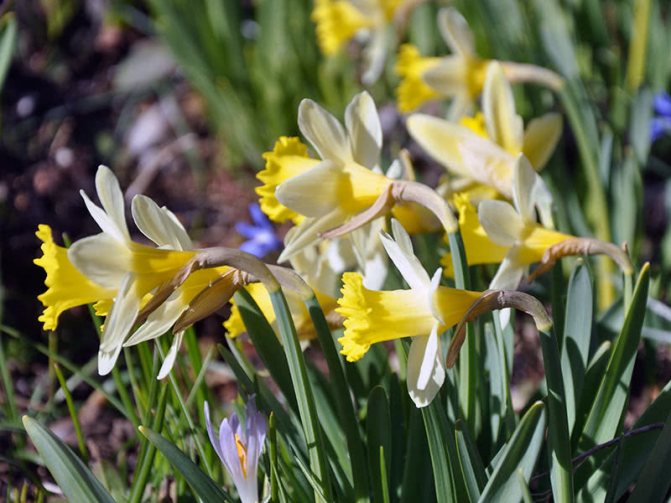

As for the bear, it is difficult to get rid of them, but if this is not done, they will multiply, and you will not have peace, since not only flowers, but also root vegetables suffer from these omnivorous pests. To lure pests out of the ground, prepare manure traps for them: in early May, dig shallow holes in different parts of the garden and spread heaps of fresh or not completely rotted manure in them. There should be two such traps per one hundred square meters.After three weeks, collect the manure along with the bears and throw it into the fire. Or give the bear to the fishermen for bait.
Slugs can be lured into beer: dig a small can into the ground so that its rim is flush with the ground, fill it a third with beer and wait until you can harvest the "harvest" of gastropods drowned in beer.
Watering daffodils
Plant care involves moderate watering. It is important to take into account the climatic features of the region. In the south, rain may be absent for a long time. Therefore, you need to regularly moisten the soil as it dries. This is especially important during the period of active growth, budding and flowering of the daffodil. But it is still important to observe the measure. Excessive waterlogging leads to rotting of the bulbs.
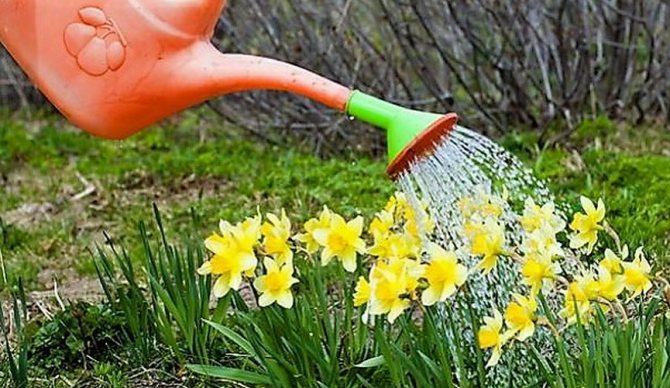

In central Russia, daffodils are watered occasionally, during periods of a long absence of rain. In the north, plants have enough natural moisture. Their vegetation begins immediately after the snow cover melts. The soil remains moist for a long time.
Even if the top layer of the earth is dry, this does not mean that the flowers are deficient in moisture. Daffodils have a powerful root system that penetrates to a considerable depth. Therefore, plants are always able to obtain moisture for themselves in the lower layers of the earth.
Watering daffodils in the summer is undesirable. During the spring, a sufficient amount of moisture accumulates in the bulb. This is its main purpose - to collect and preserve the substances necessary for plant life. Constant watering when growing flowers without digging and drying for many years leads to a gradual decrease in the hardiness of daffodils, an increase in the tendency to disease.
Nuances of the procedure
Caring for daffodils takes little time, which is why flower growers love this plant so much. Transplant is the most time consuming process. It is not difficult to master it.
See also
Description of daffodil varieties Abba, planting and care rulesRead
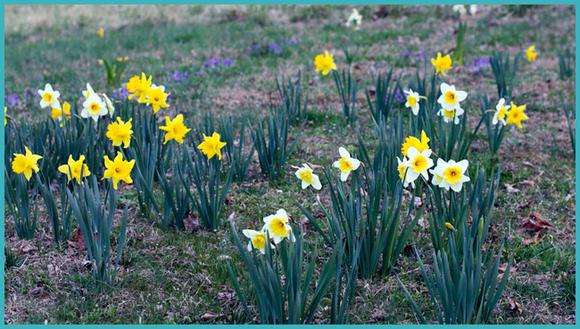

Transplanting flowering daffodils
If the bush blooms profusely, does not get sick, then it is transplanted to another place every 4 years. Sometimes a variety needs a more frequent change of location due to varietal characteristics. This is reported when purchasing a specific species. Large bulbs are planted in 15 cm increments, medium ones - 10 cm, small (children) - 7 cm.
Weeding a plot of daffodils
Any cultivated plants need protection from weeds, as well as regular loosening of the soil to create normal air exchange. Narcissists are no exception. Weeds are undesirable on the site. On the one hand, they take nutrients from the soil. On the other hand, they can become a source of infection. Weeds attract various pests and are affected by diseases. Therefore, they must be removed from the flower bed immediately.
Growing daffodils involves regularly loosening the soil. This is especially important if the ground is heavy. It is necessary to loosen the beds after each irrigation. This will make it easier for the roots to absorb water, nutrients and air.
To make it easier to care for daffodils, you can mulch the area. Humus, peat, sawdust, cut grass are used as mulch. This eliminates the need for weeding and loosening. Mulch prevents the growth of unwanted weeds, retains moisture in the soil. In addition, it serves as an additional source of nutrients. Rotting, it fertilizes the earth.
How often do daffodils need to be transplanted
Daffodils grow very quickly... Two years after planting, about five flowers can grow from one bulb. The basal linear leaves, resembling long ribbons, begin to get tangled. Such an intensity of growth can adversely affect the further development and flowering of the plant, therefore, it must be separated and planted in a timely manner.
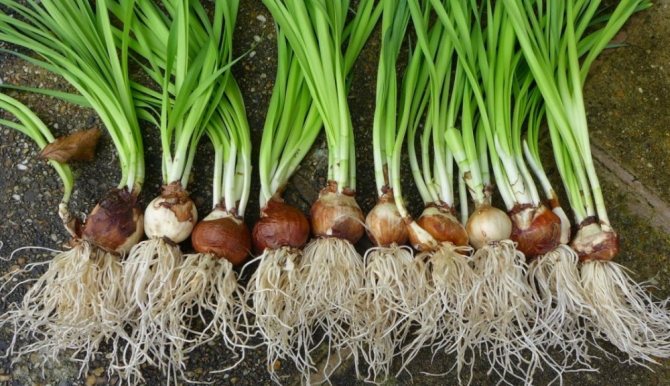

When a daffodil transplant is required:
- transplanting is necessary for those flowers that grow too closely and interfere with the development and flowering of each other;
- in cases of complete or partial absence of flowering;
- after the end of the flowering period;
- for reproduction;
- for prevention, flowers are also recommended to be planted.
Daffodils need to be transplanted every 4-5 years., since the lifespan of bulbous scales does not exceed this period, moreover, by this time they have time to grow abundantly. After planting young bulbs, it is not recommended to dig them up and replant them to a new place within the next three years. This is due to the fact that the daughter bulb will begin to bloom only after two years and will be ready for reproduction after another year.
Important! Damaged bulbs should not be used for propagation and transplantation. If signs of illness such as fungus are observed
—
the bulbs must be dug up and removed to avoid contamination of healthy neighbors.
Pest control
High-quality daffodil care involves taking preventive measures to prevent disease. For bulbous plants, the greatest danger is represented by fungi and soil bacteria. The most common:
- Fusarium. Infects bulbs through the root system. A clear sign is the underdevelopment of the plant. When digging up the material, brown roots can be seen. During winter storage, the affected bulbs rot or dry out.
- Gray rot. A clear sign of the disease is wilting of buds, massive spots on stems and leaves. May lead to plant death.
- Bacterial scab. Can affect daffodils if they are planted in areas with high water levels, clay, peat, too moist soil. The disease manifests itself in the form of brown spots in the lower part of the plant, rot of the neck of the bulb. On the planting material itself, you can see reddish spots with a varnished surface.
Fighting disease is easiest in the early stages. With fusarium, the bulbs are immersed in a 1% formalin solution for 8 hours, and then powdered with foundation. With a tendency to gray rot, it is recommended to spray daffodils with 1% Bordeaux liquid or 0.5% captan solution. In case of severe damage, the bulbs are dug up and treated with a 0.2% solution of foundationol. In case of infection with bacterial scab, it is recommended to cut out all spots from the bulb. Treat the cuts with crushed coal.


Also, daffodils can be affected by pests such as:
- Onion hoverfly. The fly hatches the larvae that attack the bulbs. It is destroyed by watering the plant with thiophos emulsion at the beginning and at the end of summer.
- Aphid. The pest carries viruses, sucks juices. You can get rid of it by spraying the plants with tobacco dust or special insecticides.
- Medvedka. Gnaws roots and bulbs. You can get rid of it by deep plowing the soil and introducing karbofos at the rate of 6 g per 1 m2.
If the bulbs are severely affected by both disease and pests, it is recommended to burn them. This will save healthy planting material from infection.
Transplant goals
The transplant is carried out not only for the purpose of rejuvenating the bush. The daffodil bulbs are dug up for distillation. For this, certain large-flowered varieties with high peduncles are grown.
To obtain material for forcing, the bulbs are dug up annually.
An extraordinary transplant is carried out if the plant does not bloom. Flower buds do not form when planting in an unfortunate place, due to freezing or diseases. Transplanting helps eliminate these problems and stimulates flowering.
Pruning
The plant does not need a shaping haircut. Leaves are removed only after their natural wilting. Only peduncles are subject to pruning. They are picked fresh to create bouquets. And also pruned after the buds wither. This is necessary to prevent fruit setting and ripening. The plant does not waste energy on creating seeds, but redirects them to strengthen the bulb.
Narcissus flower stalks are leafless, therefore they are removed with minimal injury to the plant. They can be cut with a knife, scissors or pruning shears. To avoid contamination of the daffodil through garden material, the peduncles are broken by hand. They peel off easily at the base of the bulb.
Narcissus flower - description
Daffodils are perennial plants with an ovoid, round or bulbous bulb, two to four basal linear leaves, a leafless round or flattened peduncle in cross-section with a height of 10 to 50 cm and several drooping single or collected in a brush, simple or double flowers up to 6 cm in diameter, painted usually white or yellow. The flowers of the daffodil consist of a perianth with a long tube and a six-fold limb and a cup-shaped, bell-shaped or tubular perianth. Daffodils bloom early - in April or May. The fruit of the plant is a tricuspid fleshy capsule with numerous angular or rounded seeds, which quickly lose their germination.
Today, more than 30,000 varieties of daffodil are known, and an average of 200 new hybrids of this garden flower appear every year.
Summer care features
After flowering daffodils, there are 2 options:
- leave the bulbs in the ground;
- dig out the planting material.
When choosing the first option, you must wait until the ground part is completely dry. After that, carefully cut off the leaves, clear the soil of weeds and loosen the area. At the same time, weeding should not be deep, it is important not to damage the bulbs. At the end of summer, in the absence of rain for a long time, it is advisable to water the plants. Moisture is necessary for the bulbs, which grow new roots during this period.


The second option is chosen if it is necessary to dilute the planting, multiply the variety you like, or save the plants from disease or pests. It is recommended to dig up the bulbs after the natural wilting of the leaves. This usually happens in July. It is undesirable to delay the digging time, since the bulbs begin an active rooting process in the second half of summer.
Embedment depth
We have determined when to transplant daffodils after flowering, now let's talk about the features of agricultural technology. Narcissus is very tenacious and unpretentious, so if you plant a plant even with dried roots, it will take root. The main thing is that the bulb itself is not too dry. Before determining the planting depth, you need to know what kind of soil you have on the site. The denser it is, the shallower the planting depth. Variability - from 12 to 17 cm. After you have planted all the bulbs, you need to cover the flower bed with a thick layer of leaves or sawdust. You can also use peat. In this case, the layer thickness should be at least 20 cm.
Features of autumn care
The bulbs remaining in the ground do not need special care. The only thing that can be done is to cover the area with compost or fallen leaves. But this recommendation applies more to regions with little snowy winters. If in the cold season about 25 cm of snow falls or more, daffodils have nothing to fear.
A different approach is needed for bulbs dug for forcing. They should be stored in a cool, well-ventilated place during the fall. The rest period should last about 2 months, at least. A month before the desired flowering time, the bulb is planted 2/3 in the ground.
In a pot, they are transferred to a cool, bright room. The air temperature is increased when the first peduncles appear. If it is necessary to speed up the flowering process, the temperature is increased, but if it slows down, it is lowered. To keep the opened flower fresh longer, daffodils are placed in a cool place.
When to transplant daffodils to a new location
After the decision has been made to transplant, you should decide on the period that is optimal for this. It is better to transplant daffodils in late summer - early autumn., since it is at this time that young roots begin to germinate and develop. In addition, you do not need to wait until flowering is complete, since daffodils are unpretentious and do not require special care conditions.
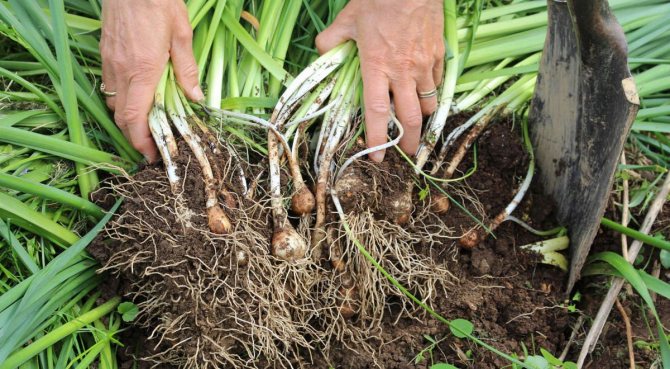

If it was not possible to transplant in the summer, you can do it in the fall. But you will have to act quickly, since with the onset of cold weather, planting daffodils is unacceptable... In extreme cases, planting material can be stored until a more suitable time, but there is a risk of drying out the roots and death of the bulb.
Also find out when is the best time to transplant irises.
Planting daffodils in the spring is undesirable, as it will be difficult to find the right planting period. It is necessary to plant immediately after the snow melts, since it will take at least a month for rooting. The soil needs to be prepared in the fall, and additional fertilizers will have to be applied. Daffodils planted in spring will not bloom for two seasons.
Transplant rules in the fall
Transplanting bulbous plants may be necessary in several cases:
- plantings are too thick;
- the flowers are sick or suffering from pests;
- it is necessary to propagate a specific variety;
- there were ideas for changing the composition.
Regardless of the reason for the transplant, it is necessary to prepare the planting material. And it is better to start doing this in the summer.
Preparing the bulbs for transplanting
The period of digging out the planting material depends on the variety, as well as the climate of the region. It can be either June or July. It is more correct to focus on the state of the leaves. As soon as they fall and begin to turn yellow, then it's time to get the bulbs out of the ground. It is not worth waiting for the complete wilting of the green mass. Lodging of leaves signals a lack of nutrition from the roots.
The bulbs are dug up with a green part; you do not need to trim the leaves. The planting material is sorted. Damaged, diseased bulbs are discarded and destroyed. Seed material is placed for a month in a warm, well-ventilated place. In such conditions, the leaves will completely die off, and the bulbs will dry out. The room temperature must be more than 20 ° C. This is necessary for the laying of flower buds. It is permissible to place daffodils on the street in boxes, in the shade of trees.
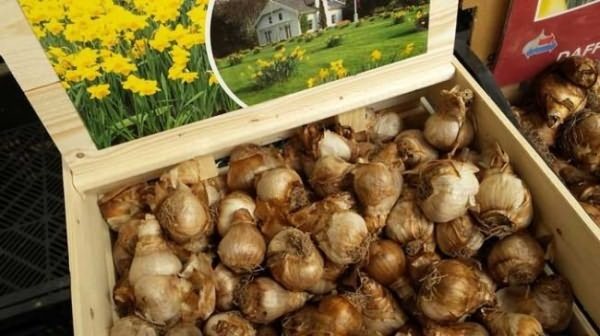

After drying, the bulbs are stored at a temperature of + 15-17 ° C. Even if they are whole and healthy, for prevention purposes it is worth treating them with antiparasitic and antifungal drugs. If the planting material does not inspire confidence or has been in contact with diseased plants, processing is mandatory. After that, the daffodils are dried again.
Planting flowers
Daffodils are transplanted in late August or early September. This is the most successful time, because before the onset of cold weather, the plants will have time to get stronger and take root. The transplant is carried out in the same way as the landing. Each bulb can be fed by adding fertilizer to the hole. It is recommended to give preference to phosphorus and potassium products. It is better to refuse nitrogen. You can limit yourself to adding wood ash.
In open ground, you can plant not only adult bulbs, but also children. They are planted on drawbeds for growing. Also, small change can be distributed in containers and grown indoors, followed by transplanting into open ground in the spring. The strongest bulbs are left for distillation.
Daffodil transplant: when you can
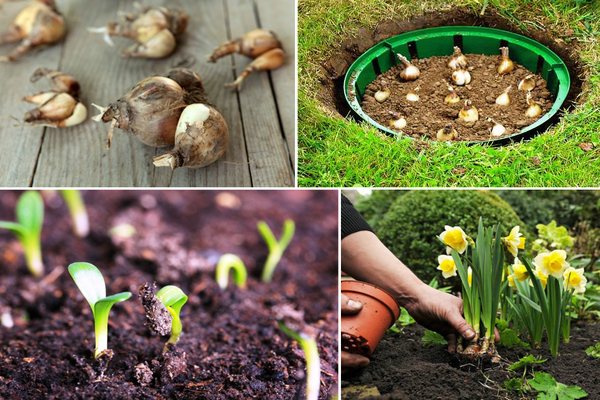

Agronomists advise replanting daffodils to a new place better in the second half of August. It is at this time that the laying of roots begins. When transplanting, monitor the moisture content of the soil; the bulbs do not take root in dry soil.
But if, for some reason, you did not have time to transplant the bulbs in August, you can painlessly postpone the transplanting procedure until the fall, but no later than September 10th, the most important thing is to follow all the transplant rules correctly.
For better survival, daffodil bulbs and babies need to be dug up when their leaves turn yellow and begin to dry out. Before planting, all dug tubers must be treated with a solution of potassium permanganate i.e. potassium permanganate.
Transplanting daffodils in spring is not recommended, as the percentage of their survival rate is much lower than at the end of summer, and some of the bulbs may die, up to about 20% of all transplanted flowers. But if you have no choice, then try to plant them as soon as the ground warms up, so that they have time to form a root system. As a rule, daffodils planted in spring do not flower until the following year.
Transplant rules in spring
Spring is not the best time to plant daffodils. On the one hand, the transplant procedure should be done as early as possible. But on the other hand, you can carefully dig up flowers only when they sprout. Before that, it is difficult to correctly determine their location and dig up in such a way as not to damage the bulbs and nearby perennials.
Even with the appearance of green leaves, painlessly getting the planting material is problematic. Daffodil bulbs go deeper below other bulbous plants, so injuries are inevitable when they are removed. It's another matter if the daffodils are planted separately. They can be dug up with the least amount of waste. But still, the breaking of the roots is inevitable.
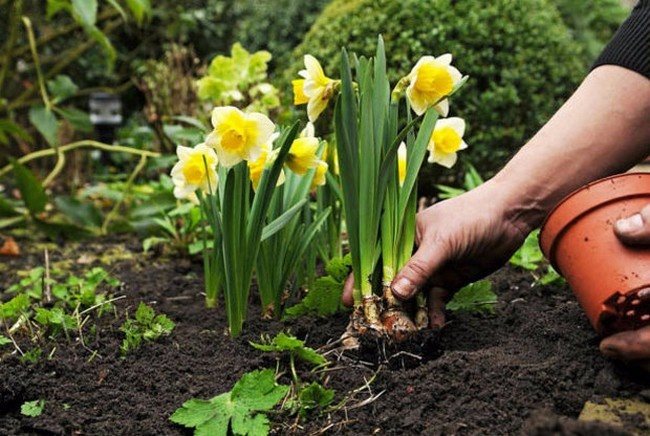

Before replanting plants, it is worth considering whether this is so necessary. If the reason is a change in design or thickened plantings, it is better to wait until autumn. If it is extremely important to transplant daffodils in the spring, it is worth doing it using the transshipment method. For this, the bulbs are dug out with a large earthen clod. With this method, daffodils bloom in the current season. If you take out one bulb at a time, you will not be able to achieve flowering.
Daffodils after flowering
When to dig up daffodils
When the daffodils are finished blooming, wait for their leaves to turn yellow and wither naturally. The wilting process can take up to two months, especially in rainy weather, but you should not wait until the ground organs completely die off. As soon as the leaves turn yellow (this usually happens in July), the bulbs are dug up, freed from the leaves, diseased and damaged by insects and rodents are discarded, and healthy ones are cleaned of dead integumentary scales, washed and placed for half an hour in a light pink solution of potassium permanganate or Maxim ... Then easily lagging babies are separated from the mother's bulbs. When breaking off the daughter bulbs from the mother bulbs, do not act with force, so as not to damage the planting material. Treat fracture areas with coal powder or ash. Dry disinfected bulbs can be stored.
Daffodil transplant
Once every 4-6 years, daffodils should be transplanted, since their bulbs become overgrown with babies, turning into nests, and begin to suffer from a lack of nutrients. You already know when and how to dig up daffodil bulbs, but if there is a need to transplant plants, it is carried out before winter, choosing another suitable site for flowers and preparing it in advance. Transplanting daffodil bulbs is carried out in the same order as the initial planting of the plant.
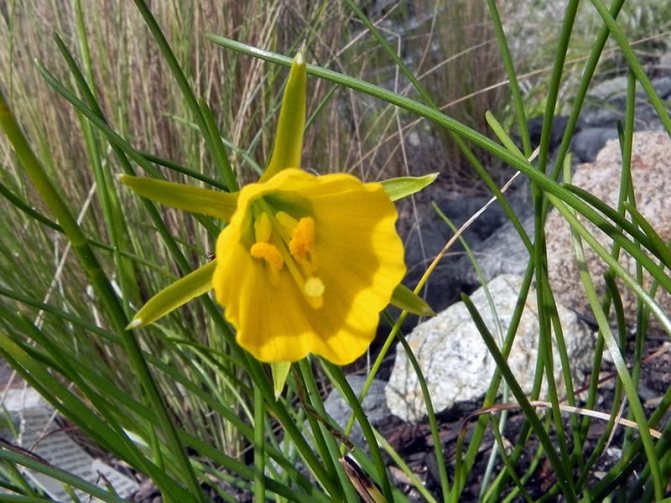

How to store daffodil bulbs
The dug out and disinfected bulbs are dried in the shade, after which they are laid out in a dry room with good ventilation and kept at a temperature of 17 ºC, spread out on paper so that they do not touch each other. However, it is not recommended to store the planting material for more than two months, as the bulbs begin to lose moisture.
Why don't they bloom
Although bulbous plants are considered unpretentious, there are still many reasons why they refuse to bloom. This is mainly due to errors in planting, non-compliance with the rules of agricultural technology. Daffodils bloom as soon as problems are corrected.
Acidic soil
Plants prefer neutral or slightly acidic areas. The optimum pH is 5-7. It is best to check the acidity of the soil before planting the bulbs. If the daffodils are already planted, you can lower the acidity level with chalk, dolomite or lime flour. Enough 200-300 g of funds per 1 m2.
Nutrient imbalance
In order for daffodils to bloom, they must receive a portion of useful trace elements for them. On depleted soils, plants lack nutrients for budding. Therefore, it is necessary to feed them with phosphorus and potassium. An oversupply of fertilizer also negatively affects flowering. Overfeeding with nitrogen leads to a build-up of green mass and a lack of flowers.
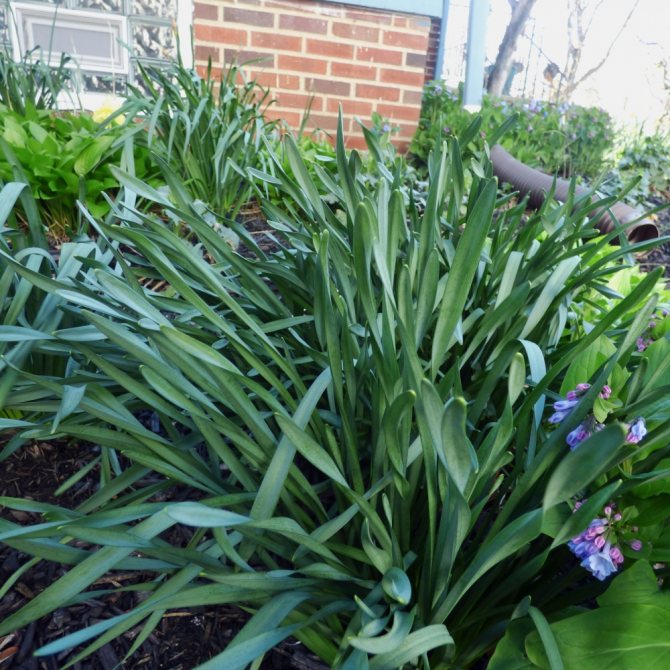

Thickened plantings
For normal development, daffodils are recommended to be planted every 5 years. If they stopped blooming, then the roots are too intertwined with each other and with neighboring perennials. Plants compete for nutrients and moisture, so they don't bud. Daffodils may not bloom in the first year after transplantation. This is due to root build-up.
Premature pruning of leaves
The green mass is involved in photosynthesis, which is necessary for the formation of flower embryos. Therefore, you cannot cut the leaves as soon as the daffodils have faded. It is necessary to let them turn yellow and dry naturally. To prevent the leaves from interfering with other flowers, you can braid them in pigtails.
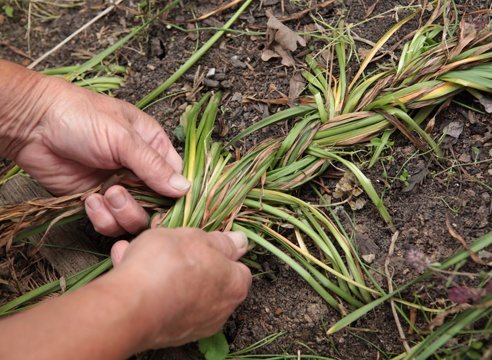

Excessive shading
It is best to plant daffodils in open, sunny areas or in partial shade. If they are grown in a garden, in the deep shade of trees, it is highly likely to get a luxurious dark green bush, but without flowers. The only possible solution to the problem is to transplant to a brighter place.
Moisture deficiency
Prolonged drought during the budding period negatively affects flowering. Daffodils need to be watered abundantly during the formation of the peduncles, as well as after the blooming of the buds. In this case, you need to ensure that there is no stagnation of moisture. Even when the daffodil has already faded, you need to water it periodically for 1.5 months. After that, a dormant period begins, so the hydration stops.
Defeat by gray mold
If the daffodil has formed a peduncle, but does not bloom, it is worth taking a closer look at the buds. Most likely they did not bloom, because they dried up. This behavior is inherent in plants affected by gray mold. The disease appears due to thickened plantings and excess moisture. Therefore, you need to reduce watering. After the leaves have wilted, it is worth digging up the bulbs and planting them. For prevention purposes, you can spray daffodils with 1% Bordeaux liquid.
Daffodils are one of the most unpretentious plants that delight with early flowering. Compliance with simple rules of agricultural technology will allow you to arrange a bright spring front garden. All that daffodils need is moderate feeding, watering during flowering, loosening or mulching the soil.
Watering
These plants need a lot of water. Drying the soil will adversely affect the flowering of narcissus buds. The soil should be loose, moist, weeded.
Narcissus: combination with other plants
A colorful ensemble is obtained from a combination of daffodils with other spring flowers: tulips, crocuses, hyacinths. Looks harmoniously with viola (pansies), peonies, daylilies. It is worth paying attention to the composition with "dwarf hyacinth" - Pushkin. It looks like a forest tree, and also blooms early.
Daffodils in the flowerbed
Try to combine the cultivation of daffodils and short perennials. In this way, create a perennial flower bed in your flower garden. The main thing is to correctly select the plants by height and color. Daffodils go well with shrubs that bloom early: hazel, wolfberry, etc.
Major mistakes
Improper preparation and wrong planting timing result in freezing, early germination or lack of flowering.
Violation of the timing of planting and digging out the bulbs
You cannot dig up a bulb with a green stem and leaves, otherwise useful substances will not accumulate in it. It is also not recommended to delay transplanting and planting until late autumn - the children will freeze or rot.
The bulbs are dug up in August, after the stems and leaves have dried.They can be stored in a semi-dark cellar, pantry at + 10-12 degrees, constantly ventilating.
Direct exposure to sunlight
The sun dries up the bulbs, they become unusable. If the children are kept in a sunny place, the plants will bloom late.
Planting bulbs without pre-cooling
The cold stimulates the immune system and the growth of daffodils. Therefore, the onions must be stored at a low temperature. Without refrigeration, the flower will grow weak and painful.
Weed control and soil loosening
Despite the fact that daffodils form dense groups and are constantly growing, these plants suffer greatly from neglect of plantings. It is better to fight weeds constantly, without giving them any chance to interfere with your favorite spring stars. For these bulbs, hand weeding is preferred over mechanical weeding.
Weeding of daffodils is combined with gentle loosening of the soil, which is carried out shallowly, avoiding the risk of injury to the bulbs and roots.
The only way to get rid of weeding daffodils and regular loosening is to mulch the soil.
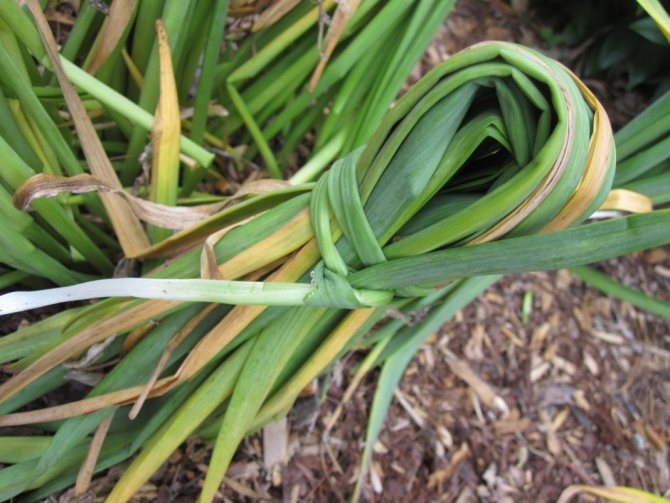

Pruning faded buds and tying daffodil leaves.
Do you need processing?
Strong and healthy daffodil bulbs do not require additional processing. For confidence and to avoid rot, the planting material can be soaked for 10 minutes in a weak solution of potassium permanganate.
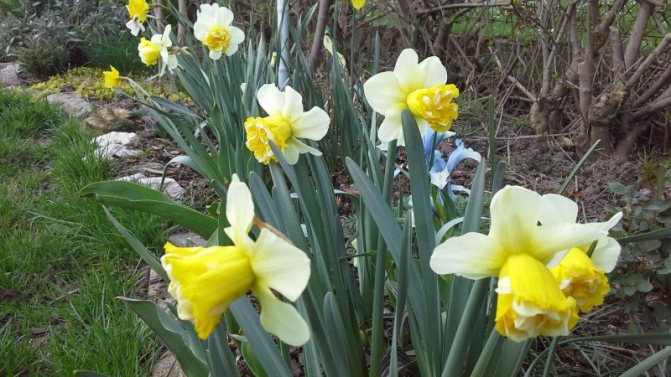

Peeled heads of daffodils, before storage, can be poisoned from worms and other pests with a solution of the drug Karbofos. To do this, prepare a solution for 2 liters of pure water, add 2 ml. drug. Place the material in the prepared solution and soak for half an hour. Then dry them thoroughly and store them indoors before planting.
Reproduction methods
Daffodils are propagated in two ways: vegetative and seed.
Vegetative method
During the growing season, 2-4 pieces are formed from the bulb. For reproduction, they act according to the following algorithm:
- The bulbs are dug out according to the technology described above.
- Mother bulbs, together with daughter ones, are cleaned of wilted residues.
- Examine the bulbs, rejecting sick and damaged ones.
- Healthy specimens are peeled and washed.
- Next, the bulbs are disinfected for 30 minutes in a 1% solution of potassium permanganate.
- After these procedures, the daughter bulbs are separated from the mother.
- If the bulb breaks off with difficulty, sprinkle with activated charcoal or charcoal.
- Delenki are dried in a shaded place and sent to storage in a room with an air temperature of 17 degrees and above.
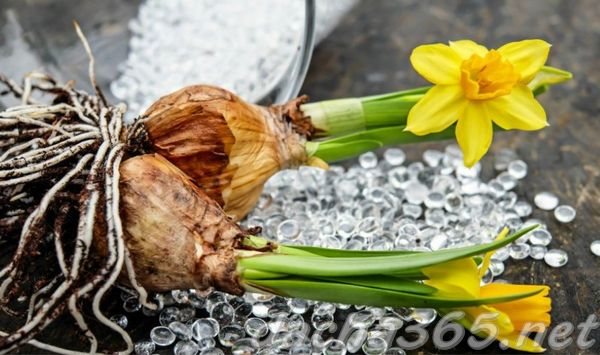

Attention! After a while, the bulbs lose moisture. Planting is best done 2 months after the bulbs have been dug.
Seed method
The seed method consists in sowing freshly harvested and non-germinated seeds. They are sown in summer or late autumn:
- Seeds are sown in boxes or on a plot to a depth of 3 seed sizes.
- For the first 2 years, the seedlings are not touched so that the bulbs get stronger.
- After that, young plants are planted in a permanent place.
- The first time daffodils will release buds after 3 years.
Attention! Only wild varieties of daffodils can be grown using the seven method. New specimens will not inherit varietal qualities.
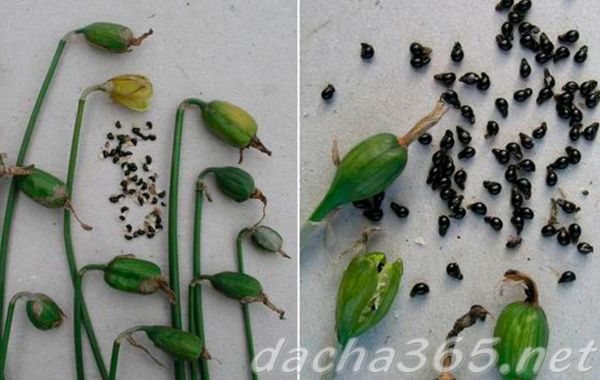

Adhering to the simple rules for growing daffodils, you can plant a variety of species of this flower on your site, which will bloom and delight the eye throughout the summer.
Choosing planting material
Narcissus reproduces by dividing the bulbs, which can be single-peaked (one apex and one bottom) and multi-peaked (have several peaks with a common bottom). If possible, it is better to choose the second option, since when planting planting material with one apex, only one stem will develop. Multi-peaked bulbs can be divided for reproduction by cutting them with a knife along with the bottom and sprinkling the cuts with ash. Such "delenki" must be kept in the shade for several days before planting.
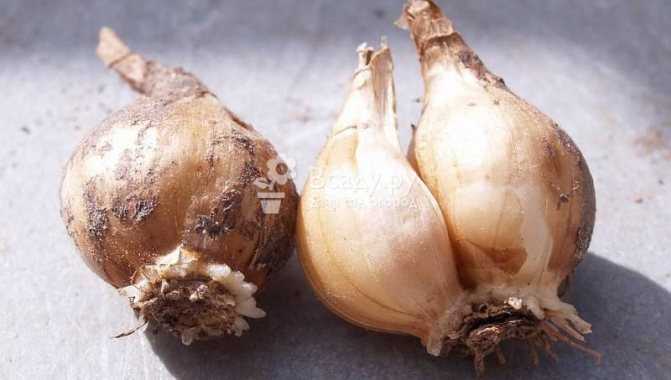

On the right is a multi-peaked daffodil bulb ready to divide
Bulbs are best purchased in mid-August, three months after flowering. In the southern regions, daffodils bloom earlier, therefore, the period for their acquisition is closer to the middle of summer.
When choosing bulbs, you need to pay attention to their elasticity and density, they should not be too soft. The bottom should ideally be clean and whole, the necks smooth and dense, without signs of rot.
It is not recommended to buy:
Bulbs that have been dug up with the remainder of the stem or are sold with flowers. It is better not to take a bulb that has begun to germinate and a young sprout has already appeared. Poor planting material also includes multi-peaked bulbs with a large number of “daughters”.
Features and varieties of narcissus
In nature, there are about 60 types of these flowers. Active breeding of daffodils every year gives new varieties and hybrids, now there are about 35 thousand of them. Sometimes they are so different from each other that even in the photo they look like completely unrelated plants. But no matter how daffodils look, planting and caring for all species are similar.
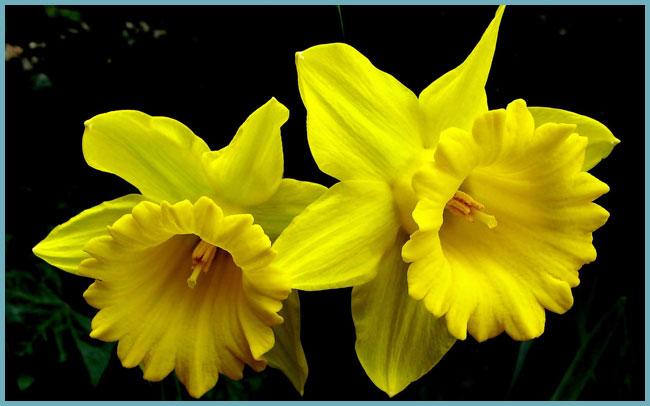

Daffodil varieties are striking in variety
In the international classification, they are combined into 13 groups, including:
- Terry;
- Large-crowned;
- Small-crowned;
- Tubular.
Plants of different classes differ in size and number of flowers on one peduncle (from 1 to 8). The main color of daffodils is white and yellow, there are many combinations, shades and variations.
There are especially interesting varieties. For example, varieties that grow up to 45-50 cm: Palmaris, Orangerie, Fortissimo. The latter also has a flower diameter of 8 cm.
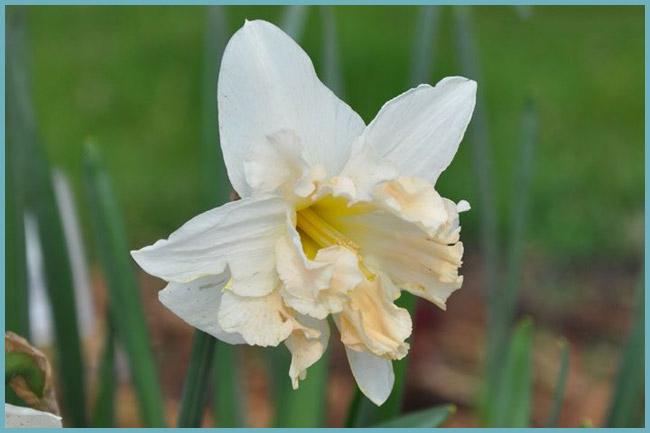

Variety "Palmaris"
Early, medium and late varieties are distinguished by the timing of flowering. When daffodils bloom, it also depends on the time of planting. This is the advantage of using them in landscaping. After all, this way you can create a daffodil flower bed that will bloom for several months. To do this, you should engage in breeding varieties that differ in flowering periods.
When daffodils should not be transplanted
Untimely transplantation can significantly harm flowers. For example, in the spring and during the flowering period, they should not be disturbed, as this can adversely affect the development and even lead to the death of the plant. Blooming daffodils are transplanted to another place only in summer, in August. Also, do not dig up the bulbs in early summer.
Summer transplanting is allowed only in August, when the roots are being laid. Haste can lead to the fact that the roots of the flower do not have time to achieve the necessary development before the onset of cold weather. Transplanting in late autumn is especially dangerous.
Did you know? Images of daffodils were found on the walls of the ancient city of Pompeii, buried under ash after the eruption of Vesuvius in 79 BC.
Young roots will begin to form during the frost period, which can stop their development. If the winter is long, the bulb will die altogether. It goes without saying that winter is absolutely not suitable for planting.
Daffodils bloom in late spring - early summer. Division takes place by seeds, they can also be divided by daughter bulbs. Flowers grow rapidly and require replanting every 4-5 years. The transplant is carried out in August or early September. Compliance with planting rules and regular care will ensure abundant flowering and long-term growth of your favorite flowers.
Reproduction
To quickly increase the number of daffodils on the site, use the method of reproduction by bulbous babies. Plants grown from seeds will bloom only after 3-4 years.
Children
One bulb produces 2-4 babies, which bloom in the first year. Signs of maturation in babies:
- the flower has grown;
- smaller buds compared to the previous year.
The division period falls on 3-4 years of plant life. They dig it out, separate the children and seat them.Separating babies is the easiest way to reproduce.
Seeds
Seed propagation is suitable for wild daffodils. Hybrids lose their species differences. The boxes are harvested in July and late autumn. After harvest, moist fresh seeds are planted in containers or open soil, laying deep into three diameters of the seed. The bulb is formed within 1-2 years. Then they are transplanted or transplanted from boxes into the soil in the garden. Flowers on seedlings will appear in 6-7 years, on small-flowered varieties in 3-4 years.
Bulbs storage rules
After being removed from the soil, the bulbs are left for 5-10 minutes in the fresh air to dry out. It is better to choose a slightly shaded place to avoid sunburn. If the weather is rainy, they are taken indoors, with good air ventilation for ventilation.
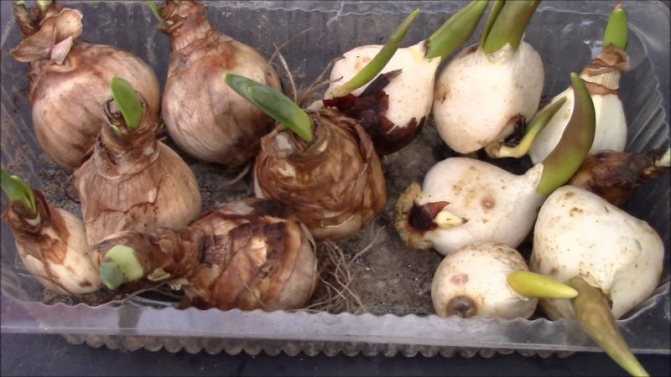

After that, they must be placed underground or in a cellar with an optimal temperature of 15-18 degrees, and a humidity of 60 percent. Before being lowered into the cellar, the bulbs are sorted by type and placed in wooden boxes or special pallets, you can shift the layers with paper. Do not store in closed bags, otherwise they will rot.
There should be vents in the underground so that fresh air can freely enter it. If it is damp, you can place a fan to circulate the air. Inspect the material for rot or disease on a daily basis. Remove rotten heads immediately so that the infection does not spread to healthy onions. It is not allowed to store them for a long time, the shelf life should be about a month.
The main types and varieties of daffodils
The most favorite and common types of this flower are the following:
- tubular - the length of the middle, the so-called tube, and the petal of the inflorescence are the same, sometimes the tube is longer than the petals;
- large-crowned - a characteristic feature is that the length of the crown of the inflorescence is approximately half the length of the petal;
- small-crowned - the length of the crown is only a few millimeters;
- split-crown - the middle of the flower is of different sizes and lengths, the main feature is that the crown looks torn or fringed. Very spectacular and beautiful inflorescences;
- terry varieties. Also beautiful and unusual plants with large flowers. Some terry varieties have very large inflorescences and the stem does not withstand such a large and heavy flower, so a special support is placed for them;
- cyclamen - the shape of the inflorescence resembles a cyclamen. The middle of this variety is long and thin. An early variety of daffodils;
- Jonquilliae are a late variety that has several small inflorescences on the stem.
Storing bulbs in winter
You can use a cellar or refrigerator to keep daffodil bulbs viable and get healthy plants with beautiful flowers in your garden next season.
After the planting material has been dug up and pre-processed, it is placed in containers filled with a light free-flowing soil mixture. You can use the mixture from sawdust and peat. In such soil, the rooting processes will be much faster. At the same time, a sufficiently low temperature will not allow daffodils to grow ahead of time.
It is not recommended to store bulbs in home refrigerators. At this temperature, they can begin to germinate. You can place planting material in the refrigerator only if no more than 2 months are left before disembarkation. In spring it can be placed in the vegetable section of the refrigerator.... The bulbs will not have time to germinate in such conditions., however, will undergo good hardening before planting.
Step-by-step transplant instructions
There is nothing complicated in the transplanting process; even novice florists can carry out this procedure. The algorithm of actions is described in detail below:
- Initially, it is necessary to finally determine the deadlineby choosing the most optimal period for this.
- The bulbs are carefully dug up. Daffodils are not afraid of the loss of root processes, and this does not affect their viability in any way, however, one should try to avoid damaging the tubers themselves, as this can lead to diseases, rotting and other processes leading to death. To increase safety, the bulb must be dug around the perimeter, and then removed along with a lump of soil. It is best to use for these purposes not a shovel, but a garden pitchfork.
- Dug out bulbs must be manually cleaned of adhering soil and carefully inspected. If traces of any diseases, damage, as well as the activity of rodents or insects are found, such specimens must be destroyed, it is recommended to immediately burn them.
- Selected bulbs are washed with warm and clean water, after which they are soaked for 30 minutes in a weak solution of potassium permanganate.
- The processed planting material must be folded into containers and placed in a sufficiently dark place with good ventilation., the most optimal indicator of the temperature regime for curing is + 17 ° C.
- After the tubers quickly dry, you can proceed to planting them in a new place. It is recommended to plant in asymmetric groups, but if you plan to cut off flowering plants in the future, then planting in even rows would be a more rational solution.
- The degree of penetration usually depends on the size of the planting material, usually it is about 12 cm, but when transplanting into light soil, the depth can be increased to 17 cm. When planting children, the depth should be 10 cm, regardless of other factors.
- The holes for placing the bulbs in them are made in advance, between them it is necessary to maintain a distance of at least 10-12 cm. Compliance with this indicator allows for a fairly dense planting, which will have a positive effect on the development of tubers and the natural increase in their diameter. However, if it is necessary to obtain a large number of children, the distance between the pits will need to be increased to 15-20 cm.
- Placed in the correct position, the bulbs are covered with garden soil on top. If the weather is dry, then the first irrigation at the new place is required.
Features of the choice of landing dates
Daffodils need to have time to develop by the April, May flowering, so they are planted in the fall. To form flower buds and strengthen the roots of the bulb, choose September or the end of August. Before frost, the length of the roots will reach 20 centimeters, which will contribute to a better adaptation of the plant. When planted late in October, the roots will grow short - 5 centimeters.
If daffodils need to be planted in winter or spring, they are previously kept in the refrigerator for 2 months. Tempering improves the rooting and flowering capacity of flowers. The bulbs are planted from the refrigerator in the second half of April, at 5-7 degrees Celsius.
Daffodil care
Watering
Daffodils love moisture, so they need to be watered regularly and abundantly at the rate of 20 liters of water per 1 sq. meter.
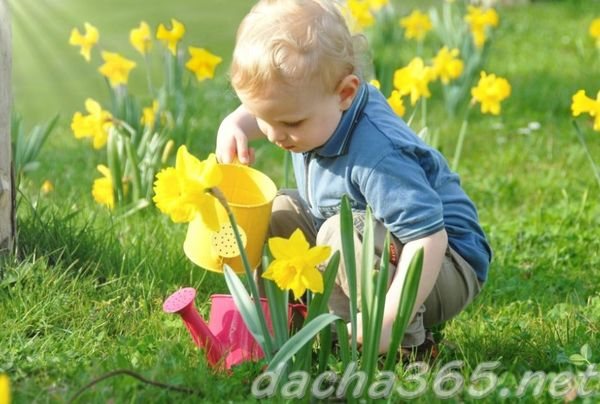

Each time after watering, the soil is loosened and weeds are removed, after which they are mulched.
How to feed daffodils
- In early spring, daffodils will begin to sprout. Immediately after the appearance of the first shoots, mineral fertilizers are applied. For 1 sq. meter make 30 g of ammonium nitrate or nitrophoska. You can also use herbal infusion for feeding.
- The second time feeding is applied during the formation of buds. This process takes place around the end of May. For 1 sq. meter make 20 g of diammophoska, nitrophoska.
- The third time, the same top dressing is applied as the previous one in 2-3 weeks.
- At the end of flowering, the plants are fertilized with a mixture of potash and phosphorus fertilizers (1: 2). For 1 sq. meter make 50-60 g of superphosphate.
Advice! After each fertilization, the soil must be watered and loosened.
After flowering
After the daffodils have faded, they continue to water and loosen them for 15-20 days in the same way.
Daffodils will delight with their beautiful flowering if they are fed and watered on time. Flowers that begin to wilt must be removed so that the plant does not waste its energy on the formation and maturation of seeds.
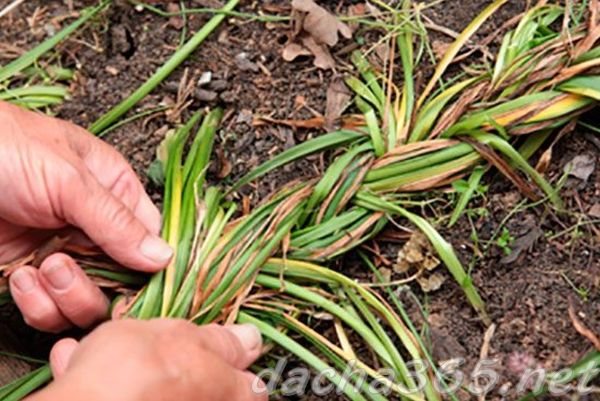

Pruning daffodil flowers and leaves
In daffodils, it is advisable to remove wilted flowers immediately, without delay, along with the peduncle. The formation of seeds in this bulbous should not be allowed (unless you leave several plants in order to collect seeds).
The leaves of daffodils are not removed until they not only turn yellow, but are also completely dry. In this plant, the leaves must die off on their own and naturally; despite the significant damage to the decorativeness of flower beds, it is impossible to "help" daffodils. The leaf drying process lasts almost a month and a half, and during this period it is better not to touch the plants.
At the slightest signs of damage to plants by diseases or pests, it is better to immediately remove and destroy them, even if the daffodils are blooming at this time.
Video: How to plant and transplant bulbous plants
Transplant in the fall
The optimal time for the autumn planting of daffodils is September, since before the onset of cold weather there is enough time for the rooting of the bulbs. Before planting, you need to decide on a place suitable for growing daffodils, prepare the soil and planting material. Then you can start transplanting flowers.
Read also the rules for transplanting gladioli.
Seat selection
For full growth, daffodils need a lot of light, so they need to be planted in well-lit places where there is no shade... If it is not possible to provide the required conditions, you can plant varieties of daffodil in partial shade that are undemanding to lighting. These flowers have a richer color and bloom longer.
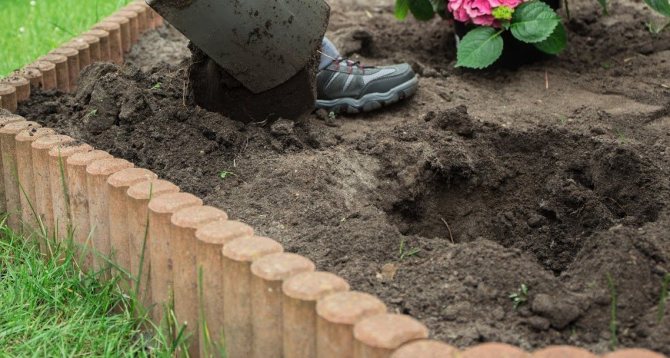

It should also be borne in mind that daffodils do not tolerate proximity to groundwater. The surface of the ground must be level and well drained. If it was not possible to find a suitable place in the garden, the earth can be leveled and drained by yourself, laying broken shards or bricks on the bottom of the hole.
Important! Daffodils should not be planted in light sandy soil, since in the cold season it does not retain heat well, as a result of which the roots can freeze.
If the soil contains heavy clay, it can be lightened by adding plant humus and peat in equal parts. Also, daffodils prefer acidic soils, if necessary, the acidity of the soil can be increased by additional liming. To do this, 400 g of carbonic lime per 1 m² must be added to the soil.
Soil preparation
Having decided on the place, the soil must be prepared in advance:
- Loosen and dig to a depth of at least 40 cm.
- Apply 20 kg of vegetable humus per 1 m².
- Two weeks before transplanting, add 50 g of superphosphate and 30 g of potassium salt per 1 m².
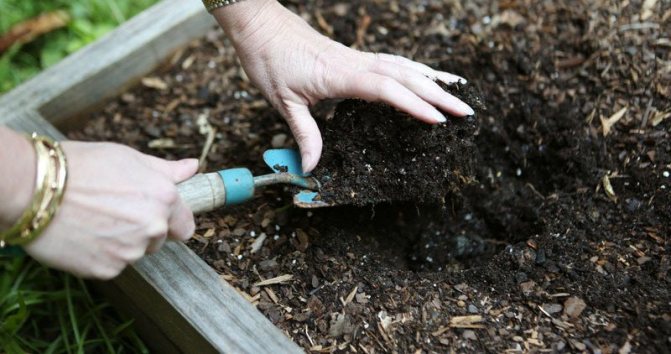

Preparation of planting material
For transplanting, you will need the bulbs planted earlier. They need to be dug out with a garden pitchfork. Carefully dig in the area around the flowers and remove together with the earthy clod. This will help prevent damage to the tubers. The dug out bulbs need to be cleaned of the ground and sorted out.
Damaged, showing signs of disease or traces of insect activity must be immediately burned. Rinse bulbs suitable for transplanting in warm water and soak in a weak solution of potassium permanganate for 30 minutes.
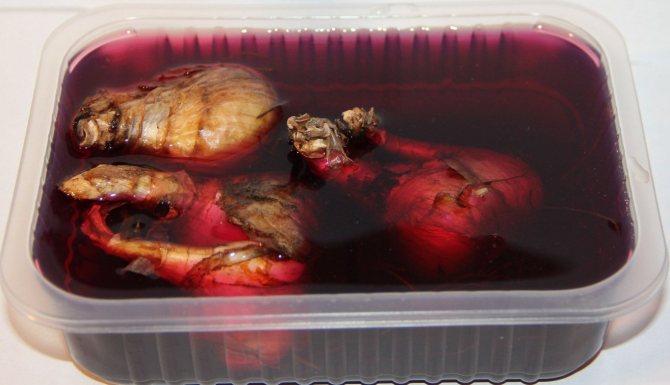

Then place the planting material in containers and keep in a dark place with good ventilation until dry. The optimum storage temperature is + 17 ° C. Once dry, the bulbs are ready to be planted outdoors.
The bulbs can also be hardened by refrigerating them for several weeks. Hardening has a positive effect on adaptability to new conditions and promotes survival.Do not put onions in the freezer.
Important! You need to carefully dig up the bulbs and try not to damage the tubers, as this can lead to their disease, rotting and death.
Landing scheme
It is recommended to plant in asymmetrical groups, but if further cutting is planned, it is more convenient to plant in even rows:
- Prepare a trench for planting bulbs. Remove the top layer of soil at least 10 cm deep. In order for flowering to occur earlier and to be more abundant, the planting depth should be shallower. To slow down development and reduce flowering, the bulb must be planted deeper.
- Fill the bottom of the trench with layers of river sand and ash. First add sand, then ash and finally sand again. The layer thickness should be about 5 cm.
- Place the bulbs at a distance of about 15 cm from each other. The larger the planting material, the greater the distance should be. You need to spread it with the bottom down.
- Cover with earth without tamping.
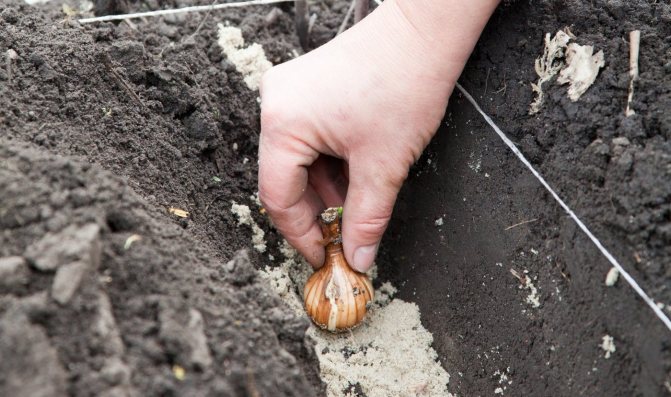

Next, you need to provide the necessary care. Water as the soil dries. In the fall, it rains often and abundantly, so the daffodil planting site must be covered with a film to protect it from excessive moisture and stagnation of water in the soil. In late autumn, the surface of the earth must be mulched: apply a layer of dry leaves and sawdust. Remove mulch in spring.
Transplant in summer
Summer transplantation is considered the most suitable, as it gives sufficient time for the rooting and adaptation of the herbaceous plant before the onset of frost. Daffodils planted in summer will begin to bloom as early as next season, in early June.... Daffodils are planted in August. The preparation of a summer transplant (choice of location, preparation of soil and planting material) does not differ from the autumn one.
Did you know? In Transcarpathia (Ukraine) there is an unusual field, completely covered with blooming daffodils. It is known as the Valley of the Daffodils.
Transplant scheme:
- Having decided on the planting site, having prepared the soil and bulbs, make a 12 cm depression in the ground.
- Distribute the bulbs at the bottom of the hole, taking into account that the distance between them should be at least 15 cm.In order to get more children during development, you can increase the distance to 20 cm.
- The bulbs must be planted strictly with the bottom down, without pressing into the ground.
- Cover with earth. No need to tamp.
- In dry weather, you can water.
In the future, it is necessary to care for the planted daffodils. Water as needed. Protect the transplant site with foil during rainy season. Closer to winter, apply a layer of mulch (sawdust and leaves in equal parts). Remove the foil and mulch in the spring.
Video: Features of planting and growing daffodils
Follow-up care after transplant
Subsequent care must be given special attention, since daffodils are perennial plants, therefore, the quality of this process will affect the flowering characteristics in subsequent years.
All stages of care are listed below:
- Initially, in the spring, you need to timely rid the daffodils of the temporary winter shelter.as exposure to too high temperatures can also have negative consequences.
- Any suitable bait mix is applied to the soil, but manure is not allowed. In early spring, ammonium nitrate is best suited for these purposes; a little later, it will be possible to use mixtures containing a large amount of phosphorus and potassium. Periodically, it is allowed to use mineral fertilizers, but it is imperative to observe the dosage and other rules specified in the attached instructions.
- Watering should be regular, the land should never be dry. For each square meter, at least 2-3 buckets of water should go, this volume will be enough to quench the thirst of the root processes along their entire length.
- After every watering or precipitation high-quality loosening of the soil near the plants is required.
- After the cessation of flowering, you can increase the frequency and volume of watering., because for another 1.5-2 months, nutrients will accumulate in the green foliage.
- At the end of June or early July, watering can be completely stopped., as daffodils begin to wilt gradually, giving all the accumulated nutrients to the tubers.
- Weeds must be removed in a timely manner throughout the season., and not only from the surface of the earth: their root shoots must also be dug up and eliminated.
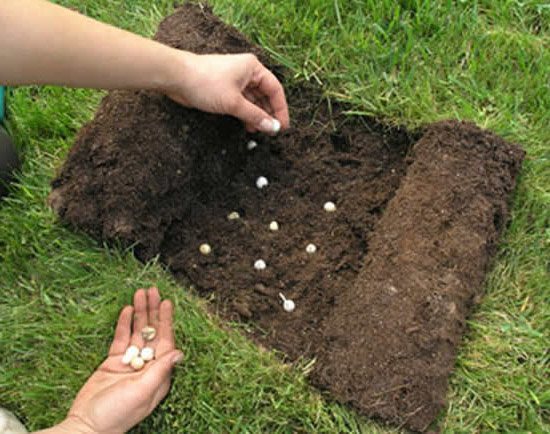

Terms of planting in the ground
The most optimal time for planting daffodils in the ground is autumn, late August, early September. During this period, the bulbs will have time to take root and not start growing. In each region, it is necessary to observe the time when frost occurs. You can independently calculate the most favorable time 3 weeks before the first frost.
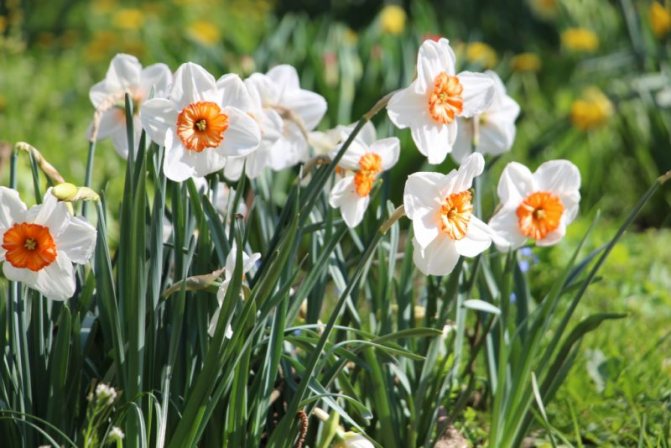

If the planting took place in late September, early October, you can cover the seedlings from above for the winter with a layer of dry foliage, tops of no more than 15 cm. To be sure that the crops are safe.
It is better to choose a new place, where there is a rested land. It is better not to plant in the same place where the daffodils grew. For 3 years, the soil is depleted, it may contain harmful microorganisms, the flowers will not grow well.
A hole is dug in accordance with the size of the bulb, about 20 cm. If fast flowering is required, it is enough to deepen it by 5-10 cm. A layer of sand, humus soil and 1 tablespoon of mineral fertilizer are placed on the bottom. Having formed a drainage layer, the bulb is placed in a hole and sprinkled on top with a layer of soil, slightly compacting it. It is important when planting to adhere to the distance between the material at least 10-15 cm. If different varieties of flowers are planted, you can deepen pegs with the inscriptions of the variety name into the ground next to the heads.
Important! The daffodil bulb is poisonous, all work and contact with them should be done with rubber gloves.
Now there is a huge selection of varietal daffodils that will delight their owner with colorful paints during flowering in early spring. Having given them proper care and observing all the planting rules, the plant will be strong and healthy, not subject to diseases and pests.
Tips for florists
Summing up, we can give the following recommendations, which will be useful to all growers interested in growing daffodils:
- After yellowing and drying of daffodils, it is better not to overexpose them in this form., and timely transplant, since delays at this stage negatively affect the quality of the bulbs.
- Even in the presence of minor injuries or lesions by any diseases, it is best to get rid of such spoiled planting material., because in the future it can cause the emergence and spread of an entire epidemic and destroy all healthy plants.
- The presence of lawn grass does not interfere with the flowering, growth and natural development of daffodils. Moreover, it is not recommended to mow it together with plant residues, as it will be more difficult for them to accumulate solar energy and accumulate nutrients.
Transplant goals
Most varieties of daffodils require a prophylactic transplant every 4 years. However, there are certain varieties that are distinguished by a too active and fast breeding process, as well as unpretentious care, they are recommended to be planted in a new place after 1-2 years.
The implementation of this procedure, regardless of the timing and frequency, usually pursues the following goals:
- Planting in different places of plants that have grown over the years, which made them feel cramped in one area.
- Thinning too dense thicketsformed after long-term cultivation in one place.
- Fight against overgrowth that causes plants to violate the boundaries of the flower bed or occupy an area larger than the space allocated to them initially.
- Stimulation of the flowering processespecially if it becomes unstable or too scarce.
- Reproduction of existing bushes.
- Preventive measures, since long-term cultivation in the same area may cause frequent outbreaks of flower diseases, and various parasites and pests that destroy tubers settle in the soil.
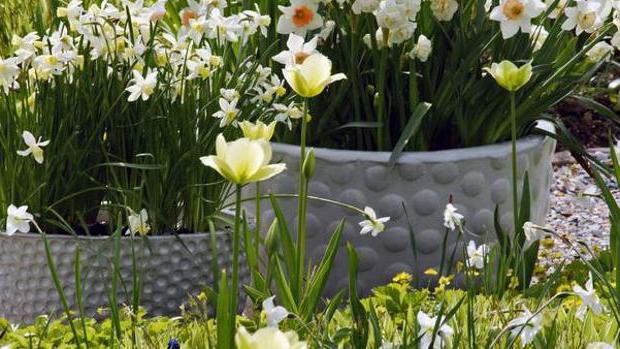

Which varieties are best for home growing
Daffodils have many varieties, which affects the color and structure of their flowers. Today there are more than 30 of them and many more breeding subspecies. Different varieties have leaves of different lengths and widths, but the color of the bushes is always rich dark green.
The flowers are yellow, white and recently hatched - a pale pink color of the crown. The structure of the petals can be smooth or terry. Since the flowers of daffodils are located on separate peduncles, pruning them does not cause any damage to the bulbs themselves.
The pear-shaped daffodil bulbs are very interesting. They have two renewing buds in their structure. Moreover, these kidneys have two completely different stages of difference. Roots grow best and most intensively in autumn. Their lifespan is about 11 months, after this period they die off.
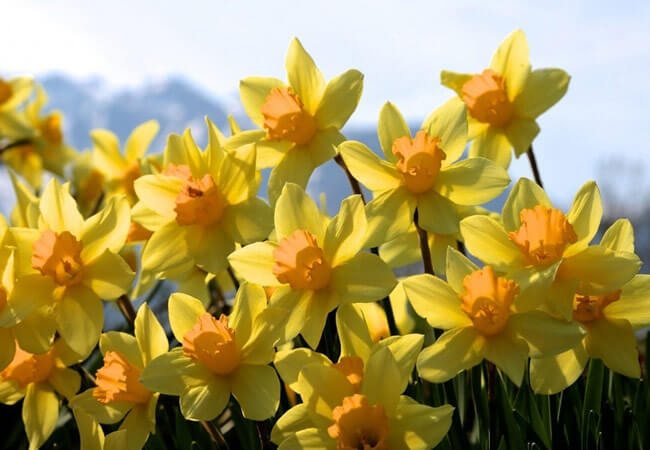

How to care for daffodils on your own
What specific varieties can we touch on? The most common are Fortune, Magnet, Yellowsun, Ziva, Inbal.
The Paper variety has become widespread. This daffodil has a large number of white flowers located on one peduncle.

